














For the past 43 years, the Shepherd Express has provided our community with a free print news publication, adding online coverage in 1995. We have been accurate, honest, informative, courageous and always willing to “Speak Truth to Power” to our large audience in Milwaukee and beyond even when it costs us some advertisers and distribution locations. We ask you to join us in supporting a free press and an informed community by becoming a Friend of the Shepherd Express.
We have never shied away from taking on the difficult and often unpopular issues. We have advocated for fairness and social justice for decades. In 1988, the Shepherd was the first to promote LGBTQ personals. A small action that may seem trivial now, but in 1988, the response was swift and nasty—threatening phone calls, the loss of advertisers, and even a death threat. We never backed down and in 2015 we created the annual LGBTQ Progress Awards to recognize our fellow Milwaukeeans fighting for social justice.
Unfortunately, the fight isn’t over. Under the guise of anti-DEI and antiwoke policy led by the White House, our entire community is under threat. Queer, Black, brown and disabled authors’ books and histories are being pulled from public access while global experts in their fields are being fired because of sexist and racist claims that they are “unqualified.” We are under threat from the erosion of democracy and progress. Fortunately, according to the polls, a majority of Americans disagree with these policies.
We must fight back in every way we can; the Shepherd will never back down. As a 100% locally owned and operated magazine, we don’t answer to some out-of-state conservative board of directors that is only focused on their bottom line and couldn’t find Milwaukee on a map. We are beholden only to you, our community, and are driven by providing honest, accurate information and supporting all aspects of social justice.
The Shepherd also endorses candidates in our local elections. Other media shy away from endorsements because they are afraid of angering readers and losing ad revenue. Our readers want fair and accurately researched endorsements before elections, so we do the legwork, from researching a candidate’s track record on issues to interviews. When we endorse candidates on the cover, we have a major impact, so we take this responsibility seriously.
The Shepherd understands our readers are smart people from all walks of life. We hire writers who don’t talk down to our readers and who write for a smart audience. We have worked to support progressive efforts by our city, county and state officials and have been very critical of those who were under the thumb of special interests.
The Shepherd has always supported policies, programs, organizations and businesses that have helped Milwaukee shed its Laverne and Shirley reputation to become a modern, interesting, exciting and forwardthinking city. Many of Milwaukee’s nonprofit organizations with their heroic missions say that their coverage in the Shepherd helped them survive by putting their accomplishments in front of our readers. Many restaurant owners will tell you that it was a Shepherd review that kept them in business. We strongly support our local nonprofits and small businesses because they are the heart of our community. This issue highlights the many neighborhood gems and institutions that give Milwaukee its character, making it a great place to live, work and play.
It has been tough times for media companies, especially print publications.
Facebook and Google push the myth that “print is dead” to sell their ad space, but studies continue to show that print is one of the most effective vehicles for advertising. We like to believe this is because our readers like us better than any algorithm.
Research has shown that news publications are critically important to communities and play a unique role in building and maintaining a “sense of community” in the areas they represent. News publications are tangible and seen by nearly everyone, whether they are reading them or not.
Our democracy is under threat. Project 2025, the current administration’s playbook, gives a clear roadmap to authoritarianism and the Trump administration has already achieved several of its goals.
The Shepherd is fighting back, ramping up our role in the voice of resistance against this effort to weaken our democracy. We are going to need your help as we continue to report on egregious and illegal actions—like the arresting of a Milwaukee judge in her courtroom for not caving to what appears to have been an illegal action by ICE and the FBI—and supporting our wonderfully diverse city.
Building a resistance effort is costly. We have just hired a new reporter who will focus on these social justice issues. Please help us support our new reporter’s salary. For over 20 years, I have gone without a salary and have subsidized the Shepherd since the Great Recession of 2008. The Shepherd, like other successful locally owned and operated news publications, has diversified its revenue base with events, new ad streams, and with the help of many of you, through your membership in the Friends of the Shepherd Express
To beef up our efforts, we need more resources. If you are trying to make your voice heard in this fight for our democracy, please support our collective effort by becoming a Friend of the Shepherd Express
As always, thank you for reading,
Louis Fortis Publisher and Editor-in-Chief Shepherd Express
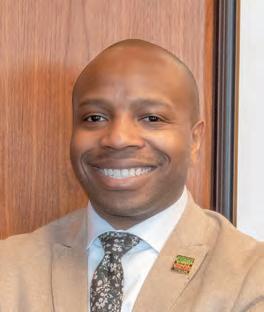


AT SHEPHERDEXPRESS , WE ARE COMMITTED TO ENVIRONMENTAL SUSTAINABILITY AND RESPONSIBLE PRACTICES.
08 Mayor Cavalier Johnson — MKE SPEAKS: Conversations with Milwaukeeans
12 Jason Gonzalez and 4th Dimension Society’s Holistic Road to Recovery — Hero of the Month 13 This Modern World
16 Who is Best in German Food? Mader’s or Kegel’s? 20 My Favorite Wine Lists — Beverages
O utdoor Dining & Drink Guide
The Milwaukee City Guide
Building Confidence in your Dog — Pets
This Month in Milwaukee
WI Cannabis Expo
SPONSORED BY

'Growing Young'? — True Health
Ask Ally
Talk to Yourself... Out Loud
Out of my Mind
HEAR ME
70 No Politics Zone — Dear Ruthie
The LGBTQ Progress Awards
My LGBTQ POV

From the City that Always Sweeps
PUBLISHER & EDITOR-IN-CHIEF: Louis Fortis (louis@shepex.com)
MANAGING EDITOR: David Luhrssen (dluhrssen@shepex.com)
GENERAL MANAGER: Peggy Debnam (peggy@shepex.com)
EVENT COORDINATOR: Jourdain LaFrombois (jourdain@shepex.com)
MEDIA SALES MANAGER: Jackie Butzler (jackie@shepex.com)
SENIOR MEDIA CONSULTANTS: Bridgette Ard (bridgette@shepex.com) Chuck Hill (chuck@shepex.com)
MEDIA CONSULTANTS: Jennifer Jepson (jennifer@shepex.com)
IN MEMORY OF DUSTI FERGUSON (OCTOBER 18, 1971 – NOVEMBER 20, 2007
WEB COORDINATOR: Caroline Dannecker (caroline@shepex.com)
DIGITAL STRATEGIST: Sophia Hamdan (sophia@shepex.com)
STAFF WRITER & CIRCULATION COORDINATOR: Blaine Schultz (blaine@shepex.com)
STAFF WRITER: Ben Slowey (ben@shepex.com)
LAYOUT AND DESIGN: Timothy Czerniakowski
REFLECT OUR DEDICATION TO REDUCING OUR ENVIRONMENTAL IMPACT AND PROMOTING A GREENER FUTURE.
MOREOVER, OUR DEDICATION TO SUSTAINABILITY EXTENDS TO THE END OF THE PUBLICATION'S LIFECYCLE. OUR PRINTED MATERIALS ARE DESIGNED TO BE RECYCLABLE, ALLOWING READERS TO PARTICIPATE IN THE CIRCULAR ECONOMY AND PLAY A PART IN PRESERVING THE ENVIRONMENT.



Distribution: New issues of the Shepherd Express magazine are on the street, on the first Wednesday of each month, free of charge. The Shepherd Express may be distributed only by authorized distributors. No person may, without prior written permission of the Shepherd Express, take more than one copy of each monthly issue. Mail subscriptions are available. No refunds for early cancellations. One year (12 issues) via First Class mail: $100.00.
207 E. Buffalo St., Suite 410, Milwaukee, WI 53202 Phone: 414/276-2222
Advertising Inquiries: jackie@shepex.com e-mail: info@shepex.com URL: shepherdexpress.com



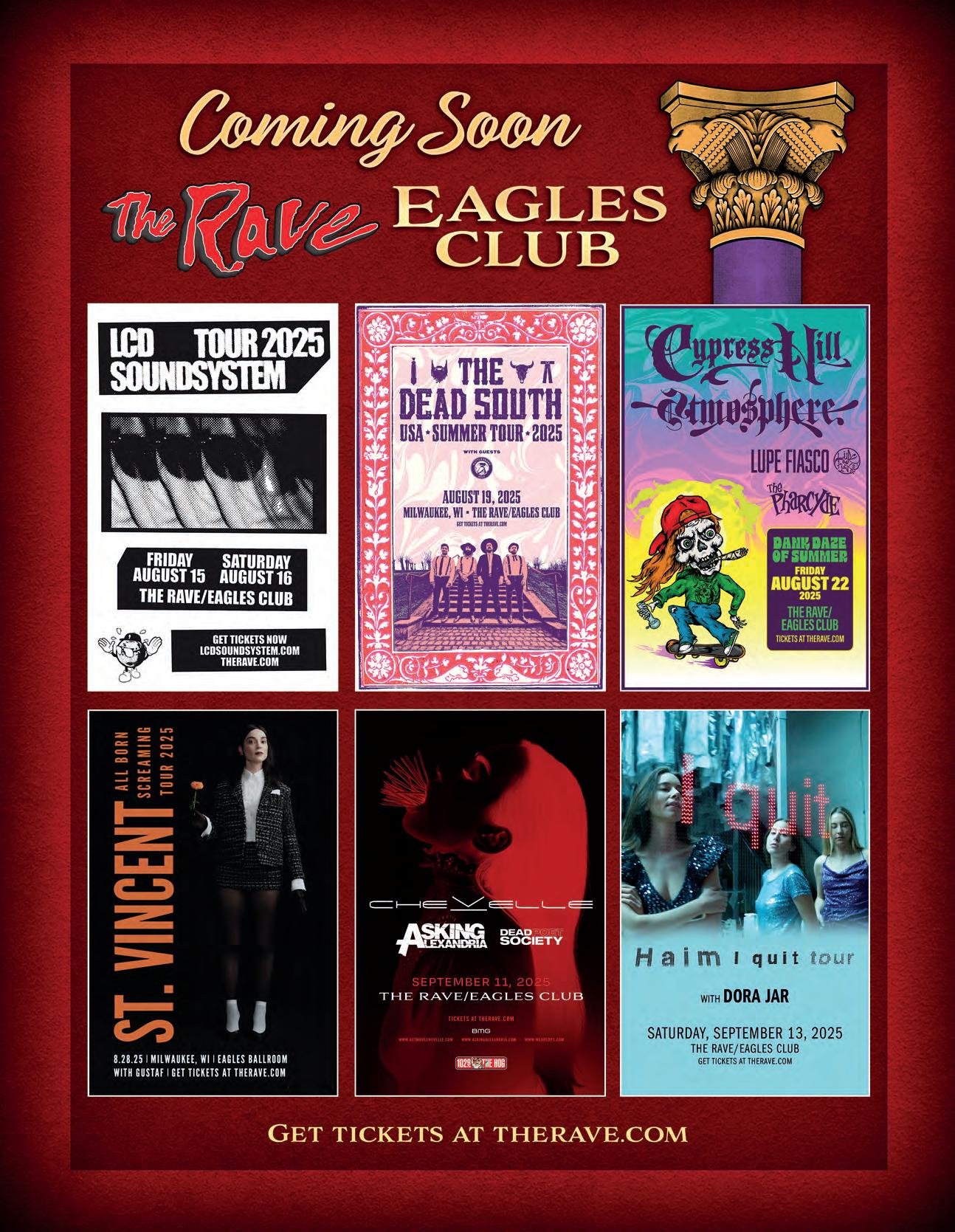



‘A LEADER HAS TO STAND UP AND LEAD EVEN IF SOME RESIDENTS ARE NOT HAPPY’
BY TOM JENZ
early four years into the Milwaukee Mayor’s job, Cavalier Johnson, at only 38, wears the mayor’s mantle like a favorite pullover. When I walked into his office, the mayor was watching on screen as members of Milwaukee’s Common Council debated his zoning proposals. As I was to find out, zoning is a priority on his agenda.
I’ve known Mayor Johnson for over five years since he was the 2nd District Alderman. Nearly four years as mayor has not changed his appearance—still that boyish face with the magnetic smile. But now, at 38, he was dressed in a sharp slate suit, white dress shirt and a timeless-style necktie. We sat in wing chairs, a table between us. He leaned forward in his chair and focused his attention on me through stable eye contact.
Crime is a big issue. According to the MPD crime maps, in the past two years, almost every category of crime is down, the total being down more than 20%. To what do you attribute the decline?
When I first ran for mayor, public safety was high on my agenda and still is. We’ve had a two-pillar strategy— accountability and prevention. Let’s take accountability. People out there who think of causing death, harm and destruction, they know there will be a consequence. The police will arrest and process you, and the courts will hold you accountable for your crimes.
What about the other pillar, prevention?
We work hard to see we have strong workforce development programs. For example, various summer programs like Camp Rise where kids can earn money, and there is Safe & Sound. If you need help finding a job, call Safe & Sound. We also work with the faith-based communities and nonprofit organizations.
If you have a decent job, you most likely will not commit a crime. I see that as crime prevention. Every year, I work with the Milwaukee Public Schools to do two things. One, I want children to understand that I grew up in the same neighborhoods they did and that I focused on education and hard work. I also prioritize the trades to show kids that there are good paying opportunities in the trades. Jobs are important, good for families, selfesteem and also for safe stable neighborhoods.
You stated that your budgets are investing more in police personnel, and you aim to add to the number of officers.
Every year, I propose a budget that includes growing the number of police. To have accountability and prevention, we need more police officers to enforce the laws and be proactive on the streets. But it is a challenge to recruit police officers.
Do you ask the Common Council for a certain number of new police officers?
My budget allocates enough police to cover three recruiting classes each year. Theoretically, there can be 65 recruits for each class, although the classes are not always filled. It is difficult to recruit police. Not that many people want to become police officers. But all I can do is try to allocate the resources.
What are the Bright Line street lighting improvements, where is this happening, and is this part of crime prevention?
Yes, this is one of our prevention strategies. We’ve employed federal funds to invest in brightening thousands of streetlights in a number of corridors. Bad guys don’t like bright lights, cameras, or witnesses.
Russell Stamper is the alderman of the central part of the inner city: a majority of his constituents are Black. I recently did a story on him, asking his top concerns. He said, “Number one is reckless driving and speeding.” As a driver of inner-city streets, I witness too many speeders and careless drivers, too many red lights ignored. Your thoughts on this problem?
We’ve taken a strong and visible approach to the problem of speeding and reckless driving. That’s why we’ve built so many pinned-on curb extensions and refuge islands for pedestrians. That’s also why we’ve installed so many protected bike lanes. One of the goals is to prevent speeders from passing on the right. Public Works data show precipitous drops in speeding in those neighborhoods with the added installations.
In your State of the City address, regarding crime prevention, you said, “I want young people to see positive opportunities in their future.” Regarding my own observations—because of the long legacy of slavery and generations of prejudice, racism and also government welfare and public housing funding, many urban Black citizens view themselves as victims. In Milwaukee, some children never leave their city blocks, visit Downtown or Lake Michigan. Many cannot see a future, much less hope. Too many are low income or dependent on government support. You yourself came out of this kind of background. That is exactly the reason why I visit public schools and engage with students, kids who look like me, who live in the neighborhoods I grew up in. I am not naive to those challenges because I lived them. In schools, I try to impart mentorship lessons that were important to my life. I came from a single mom family with five kids.
Your family was poor at one time. Yeah, I’ve seen it all, and I know the bad stuff out there, but my mom never gave up. Hers has become my own philosophy. Keep on working. Keep on fighting. Never ever give up. My good friend, Victor, whose family immigrated here from Mexico, couldn’t speak English at first. I met him when I was 14. He taught me that no matter where people come from, no matter their looks or religion, they can build bands of brotherhood. My stepdad taught me it costs nothing to be kind. I think that people should change to the things they are passionate about.
Let’s talk housing. Quoting you: “I want strength in our housing options. That’s why I support comprehensive updates to our residential zoning rules.” What should be those zoning updates? I brought forth a policy to change the zoning rules in Milwaukee. The council is debating that policy currently. There is a lack of housing in Milwaukee as there is elsewhere across the country. Which means rents go up. For Milwaukee to be an affordable city to live, I want to make sure there is more room for housing development.
If you alter the zoning rules, does this mean that more developers can build new housing? Exactly. We need to make sure there are more spaces for housing to be built, and that means housing will cost less.

Why would any alderman be against that policy?
I do think the Common Council wants to get rezoning across the finish line. I’m glad we are having this conversation, but my goal is to increase housing choices. For instance, we need to allow accessory dwelling units, meaning existing homeowners can add attached units onto their homes for aging relatives or young adults to live. Expanding on this, the more people who live in the city, the more they support businesses who are likely to hire local residents.
A recent study of 50 cities ranked Milwaukee 30th in the country—tied with New York City—on rental affordability for a minimum wage worker. You said, “We shouldn’t be that expensive. My administration is thoughtfully exploring ways the city can address the high cost of housing.” What might be some of those ways?
Besides changing the zoning laws, I think we need more affordable housing. I support changes to state law that will allow us an additional year to capture more resources and invest those funds into more affordable housing. There is also workforce housing, the city working with the private sector to bring down construction and rental costs. I want people to have homes in our city.
Let’s talk public housing. The Housing Authority of City Milwaukee, HACM, has had dysfunctional issues in the past few years. The new board of directors seems to be planning positive changes, but few are yet to happen. HACM is a complex bureaucracy. HUD (the federal Housing and Urban Development agency) provides funding for HACM through Housing Choice Voucher programs. But try to figure out the HACM chain of funding, which comes from HUD, state and federal grants, private donations and rent from public housing tenants. Do you, as mayor, have anything to do with overseeing HACM?
For HACM, I have one indirect primary responsibility as mayor. I appoint the HACM board members, and the Common Council approves them or not. The HACM board members then hire the HACM executive director. HUD is the primary source of funding, but for decades, funding has not kept up to what is needed. That leads to problems in living conditions in public housing. Currently, the board seems to be functioning well.
I know you are concerned about the low achievements of Milwaukee Public School students. You said, “I am inviting MPS Superintendent Cassellius to work more closely with the members of my cabinet.” But aren’t public school issues the responsibility of the school board? The mayor does not oversee MPS, right? Right. Just like HACM, the MPS school system is separate from my authority. But we do try to help fix the school system. I have been working with the new superintendent, Dr. Cassellius, to have her become a part of our team to address the MPS issues. For example, the City Health Department is working with MPS to reduce the threat of lead paint in the older school buildings.
Another thing—we’d like to see some of the vacant school buildings sold off to make room for more housing. The MPS superintendent should be part of that discussion. She was part of our last cabinet meeting.
Of course, all this is to ensure students have a better education at MPS. You brought up the low achievement of MPS schools. This has been happening for decades back when the mayor’s office and MPS had a strained relationship. The future of Milwaukee depends on what comes out of Milwaukee Public Schools. I am talking about tens of thousands of young people who affect public safety, the business workforce pipeline, and whether we will have strong homeownership in the future.
For some reason, citizens seem to demand perfection from their political leaders, and yet they do not demand the same from their family and friends. I find hatred over political differences sadly toxic. It is a cancer in social media and in legacy media. I explain to people that their mayor, senator or president cannot please them all the time because he or she is a leader of all constituents. My question to you: “What is it like to be a politician? How do you balance your life?”
When I walk into the mayor’s office every day, I know I cannot make every resident happy, cannot say “yes” to everyone. Every time I say “yes” to someone, I am saying “no” to someone else. A leader has to stand up and lead even if some residents are not happy. But I try to focus on the north star—what’s best for the city, the constituents, and for service delivery out there in the neighborhoods. Milwaukee is the business and population center of the state. People from the suburbs commute into the city every day, and that is a lot of constituents for me to balance priorities, but I have to.
You’ve spent your work life in and around politicians and being a politician, and now you are the city’s biggest politician.
Many years ago, I worked as a staff member in this very office. There were many days and nights I was here alone and working, and I was tempted to sit in the mayor’s chair. But I said to myself, the only way I would sit in that chair is if I earned it.
Tom Jenz is a Milwaukee writer-photographer and regular contributor to shepherdexpress.com, including his column, Central City Stories.



BY BEN SLOWEY

The sober living community at 4th Dimension Sobriety, located at 500 E. Center Street between the Riverwest and Harambee neighborhoods, is led with a carefullytailored holistic approach. Founded in 2012, the organization prides itself on being Milwaukee’s largest sober living space, offering a multitude of drug and alcohol addiction treatment options ranging from 12-step programs to therapy and counseling to transitional housing. Founder Jason Gonzalez uses his lived experience, leadership skills and commitment to accountability to sustain a thriving sober living community that sits at the intersection of faith, recovery and transformation.
“We try to hit three parts: the head, the hands and the heart,” Gonzalez says. “The mind is always an important thing to feed with knowledge. The hands are what we do with our days to serve and help our community. With your heart, what are you doing to fill your malnourished spirit? That looks differently for a lot of people.”
In addition to being a sober living house, 4th Dimension Sobriety helps clients find work, pay bills, establish healthy daily routines, exercise and meditate, and be accountable to positive life changes throughout its three or six-month programs. Residents of the house are provided food, clothing and toiletries in a safe, structured and supportive environment. The organization hosts events for residents like art gatherings and family dinners.
Volunteers help with the daily maintenance, housekeeping and meal preparation. 4th Dimension Sobriety accepts monetary donations as well as donated goods like paper towels, bath tissue and furniture.
“Most of our staff are in recovery,” Gonzalez mentions. “We’ve all been there. We’ve all lived it. It’s a level of understanding we have.”
Addiction and substance abuse can affect anyone of any background, class, or level of education. Gonzalez grew up in Riverwest with a big, loving family. He was privileged with a quality education, and he attended college at both Milwaukee Institute of Art & Design (MIAD) and Saint Louis University. However, as he attests, “None of that stuff matters when it comes to drugs and alcohol.”
Gonzalez, a high school teacher, reckons that he was always able to put on a front for people to make it seem like nothing was wrong. Behind the scenes, however, he was struggling.
“If I got good grades, no one was going to ask any questions,” he adds. When it got to the point that he could no longer hide his drinking from others, Gonzalez sought help. He found a sober community group down the road from his Riverwest home. There, he learned new ways to love both himself and others, be of service, and live by principles.









“It was almost like not drinking was the easy part,” Gonzalez remembers. “Being honest and trying to repair your faults in the past was the hard part.”
Five years into his recovery, Gonzalez came across two young men who had just been kicked out of their living situation. He took them in, and then when they left, Gonzalez took in several more people. At one point, Gonzalez had 14 guys living in his house.
“We were all trying to do the same thing, practicing our principles,” he explains. “We had a pretty rigorous life. Our meditation meetings would start at 5:30 in the morning. Then we would go to work, and come back home, and we had a set of things that we had to do until night that was all about holding one another accountable and truly building a brotherhood.”
This group eventually became 4th Dimension Sobriety, and they would open a women’s sober living house as well as a treatment center at 1216 N. Prospect Avenue. During Covid times, Gonzalez connected with real estate developer Juli Kaufmann, who owned the building that previously housed Cream City Hostel. In 2023, after earning several grants, Gonzalez secured the building as the new, permanent home of 4th Dimension Sobriety.
“When I got sober, I didn’t realize that I wasn’t drinking because I had a thriving recovery community with me,” Gonzalez affirms. “Whatever we’re doing has to have depth and weight to it if it’s going to keep us around.”
He concludes with a message for those on their own recovery journeys, “You’ve got to start very small and just do the next step. If that means picking up the phone, then that’s what that means. Slow down, and the next thing will come.”
This summer, 4th Dimension Sobriety is hosting biweekly art gatherings where murals meant to represent sobriety and recovery will be painted. Anyone seeking help may either contact 4th Dimension Sobriety at 414-323-9266 or fill out an admission application. If 4th Dimension Sobriety does not have a bed available, they will recommend clients to fellow sober living communities.
Ben Slowey is a Staff Writer for the Shepherd Express.








AWho is Best in
Food?
or Kegel’s?
Who is Best in German Food? Mader’s or Kegel’s?
BY HAZEL WHEATON
s food fads come and go, German cuisine is rarely on trend, but in Milwaukee it never goes out of style. Not surprising, considering how deeply German culture is embedded in the city’s makeup. While 17% of the population of the United States claims German heritage, that figure zooms up to 45% in Wisconsin. Starting in the 1830s, a flood of German immigrants made their mark on Milwaukee’s arts, architecture, industry and education, and turned brewing into big business. Along with the German people came German restaurants. Today, there are great options for satisfying cravings for wiener schnitzel, sauerkraut and pretzels, at restaurants like The Bavarian Bierhaus, Von Trier, Old German Beer Hall and Milwaukee Brat House. But as far as true old guard establishments go—restaurants that don’t just tap into the city’s German history but have been part of it for more than 100 years—there are now just two: Kegel’s Inn and Mader’s Restaurant.

Both have loyal followings, and debate over which is best persists wherever diners compare notes. Mader’s dominates city-wide polls, winning “Best German Restaurant” in the Shepherd Express’ annual survey from 2018 through 2024, with Kegel’s snatching victory in 2022. I dined at both restaurants in preparation for writing this article and deem those survey results correct … but incomplete. The two establishments occupy different niches in the landscape, and a one-to-one comparison of identical dishes misses that point.
After all, French restaurants come in five different types, from an ultra-casual tabac up through cafés, bistros, and brasseries to formal restaurants; why would it be any different for German food?
Dining at Mader’s is a splurge-worthy affair, demanding multiple courses and a wander through the onsite museum that hosts a $3 million art collection, including pieces dating back to the 14th century). The excellent serving staff, dressed in lederhosen and dirndls, bustle without appearing to rush. Mader’s boasts of being the restaurant in Milwaukee most visited by celebrities and backs it up with photographic proof. The list of visiting celebs on their menu is continually updated, so the likes of Billie Eilish, Usher, and Vincente Fox share space with Nat King Cole, Tony Curtis and John F. Kennedy. It’s a tradition to have your picture taken in the huge velvet-upholstered chair that stands guard in the entryway. The whole evening is an event, and not a cheap one—you’ll take a hit to your wallet, and you’ll like it.



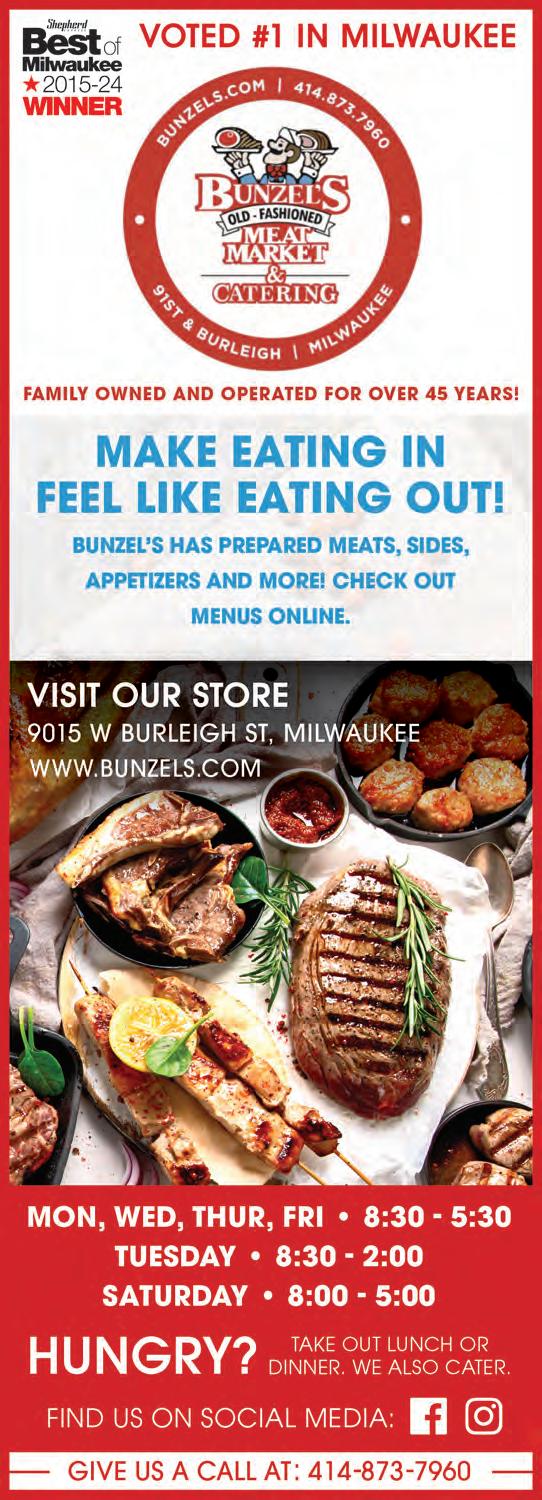
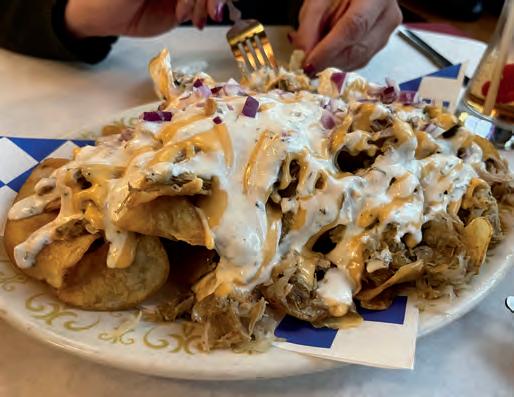
By contrast, Kegel’s is less formal and more laid-back; it’s a neighborhood haunt, suited to a weeknight dinner or a weekend hangout. Rather than a grand space, it recreates a rustic German beer hall; the walls of the dark, woodpaneled dining room are adorned with hand-painted murals depicting often humorous scenes of hunting, feasting, drinking, and general revelry. (Kegel’s has its own reason for boasting: It gained a spot on the National Register of Historic places in 2010.)
Both restaurants offer traditional German fare—you’ll find rouladen, hasenpfeffer, roast duck, sauerbraten, liver dumpling soup and an array of schnitzels on both menus. Mader’s has made updates subtly, without obvious or radical changes to their recipes. We shared an order of caramelized Brussels sprouts ($15) as a starter; the fresh and tart dish was a cross between a warm German-style salad and sauerkraut, with melted Swiss cheese holding it together and a red wine gastrique adding tang. I ordered the Rhine Sampler ($43) to taste two different entrees: The beef goulash was rich, hearty and complex, served over a bed of delightfully light spaetzle, and the wiener schnitzel was tender, with a light, perfectly crispy coating. My companion had the pork shank ($44), which was literally fall-off-the-bone tender: The bone she held up for inspection was perfectly bare.
BAVARIAN NACHOS?
Kegel’s takes more chances in modernizing their menu. They also serve pork shank, but also use the meat to create Bavarian nachos ($14), pork shank rolls ($10) and pork shank hoagies. Their sausages show up in traditional Bavarian-style sausage platters (2/$19; 3/$26; 6/$33), but also are sliced up and served in an Alpine poutine ($16), topping French fries with cheese curds, bratwurst and duck gravy. They offer a host of loaded brat options ($15-$17), reflecting a more freewheeling attitude toward their culinary roots.
The difference in attitude—respectful authenticity vs. mischievous tweaking of tradition—was there from the beginning. Charles Mader’s dream was to open his own tavern, which he did in 1902. When Prohibition passed in 1920, he thrived by concentrating on his wife’s sauerbraten, pork shank, and wiener schnitzel. Kegel’s, by contrast, debuted as a speakeasy in 1924, calling itself a “soft drink parlor” with straight-faced innocence all while brewing beer in the basement. At Mader’s, elaborate stained glass panels separate the main dining room from the Knight’s Bar. At Kegel’s, their lovely and more modest stained glass is on the outer walls, blocking the patrons from the eyes of the authorities.
Recent additions Kegel’s has made embrace its more rollicking flair. In the summer, they offer live music and outdoor dining at Oktoberfest-style long tables in “bootleggers alley” behind the restaurant. A drive-through window handles the demand for their rightfully famous Friday Fish Fry ($15-20, $32 for a sampler); diners can choose between cod, lake perch, walleye, grouper, catfish, baked cod, and jumbo shrimp—there’s even a vegan option.
So, if you have a craving for German flavors, and want to visit a restaurant that has stood the test of time and thousands of diners, just match the place to the occasion and you can’t go wrong.
Mader’s Restaurant
1041 N. Old World Third Street madersrestaurant.com, (414) 271-3377
Hours: Monday–Thursday, 11:30 a.m.–9 p.m.; Friday–Saturday, 11:30 a.m.–10 p.m.; Sunday, 11:30 a.m.–8 p.m.
Kegel’s Inn
5901 W. National Avenue kegelsinn.com, (414) 257-9999
Hours: Tuesday–Thursday & Saturday, 4 p.m.–8 p.m.; Friday, 11 a.m.–9 p.m.; closed Sunday & Monday
Hazel Wheaton is a Milwaukee writer and the Shepherd Express magazine’s regular dining critic.
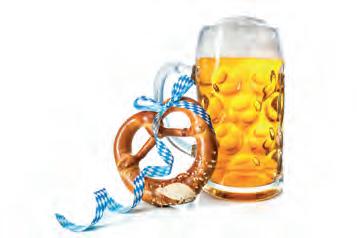



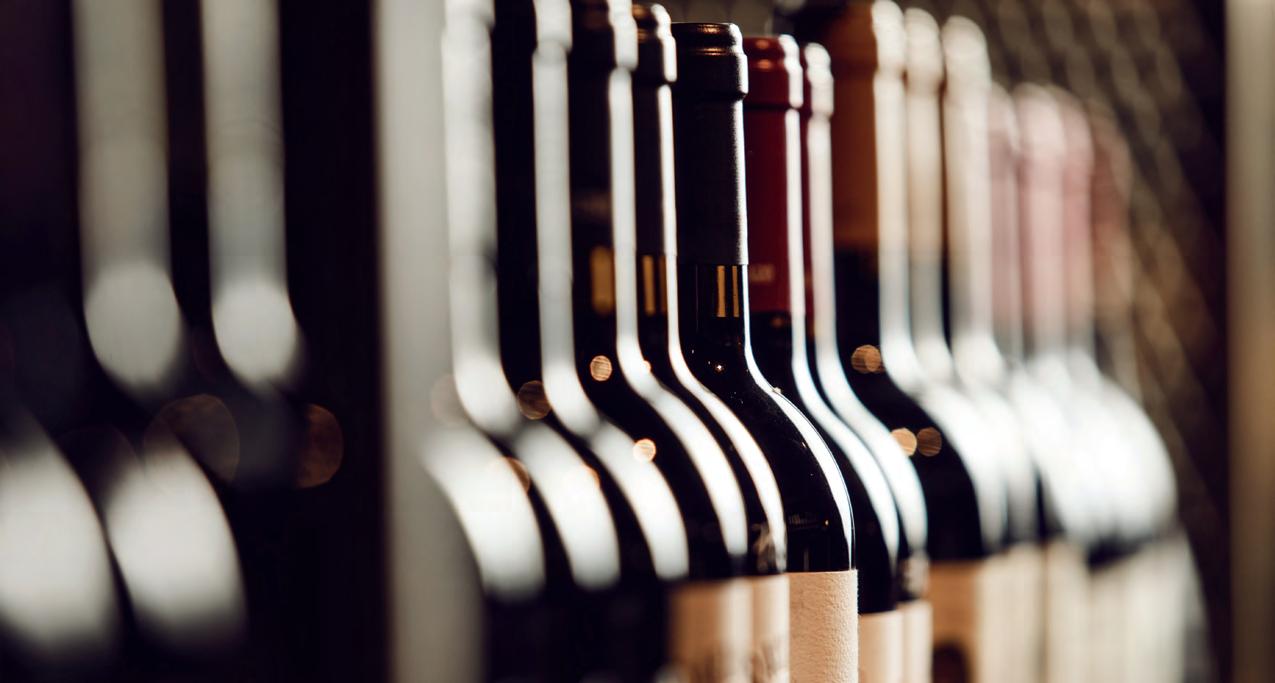
BY GAETANO MARANGELLI
Being the beverage director of a restaurant sounds like a glamorous job, doesn’t it? You meet with all kinds of distributors and importers, winemakers and estate representatives. You taste wines, beers, spirits, ciders, sake—all kinds of fermented beverages from all around the world. You write your restaurant’s wine lists. Your lists read like poetry. They cultivate a following for you and your exquisite palate. You collaborate with your chefs to create harmony with their menus. You recommend wines to your followers. You pour their wines. You make them happy.
A restaurant beverage director who curates a great wine list is assiduously, indefatigably, devotedly and exhaustively exploring the world of wine. But being beverage director is just one of the two, or three, or four, or five or more titles and sets of responsibilities a restaurant depends on them for. All of which makes a restaurant with a great wine list—whether it’s an epic or a sonnet, a ballad, an elegy, or an ode—an extraordinary anomaly.
In the city of Milwaukee, these are my favorite restaurant and wine bar wine lists.

925 E. Wells St.
Why its wine list is poetry: The list at Bacchus is an epic of more than 700 wines. It hues to convention, but every palate can find joy among its labels. If you want to appreciate the list, arrive an hour before your reservations, sidle up to the bar, and pour over it with a glass of Champagne.
Who curates the wine list?: Jared Salisbury, certified sommelier and manager.
What else does he do at the restaurant?: He assists with all of the day-to-day duties of managing the restaurant.

459 E. Pleasant St.
Why its wine list is poetry: Birch has a pitch-perfect, Eurocentric wine list replete with fashionable, benchmark producers, many of whom have recently graduated from avantgarde to modern classic (e.g., Frank Cornelissen, Arnot-Roberts, Domaine Comte Abbatucci). The restaurant favors wines of elegance and balance, a sensibility matched to its cuisine.
Who curates the wine list?: Kyle Knall, chef and co-owner.
What else does he do at the restaurant?: Among his exhaustive list of responsibilities as chef and co-owner, he shops for produce at the West Allis Farmers’ Market.

2101 N. Prospect Ave.
Why its wine list is poetry: Strange Town is one of the city’s two great champions of natural wine. Its list is relatively small, but it’s edgy, inspired, and ever-changing.
Who curates the wine list?: Mia LeTendre, chef and owner.
What else does she do at the restaurant?: “Aside from buying the wine," says LeTendre, “I’m also the general manager, prep cook, food menu creator, et cetera. I oversee all aspects of the restaurant, from daily operations and staff management to menu development and financial planning. It's a hands-on role! I’ve learned to be a jack of all trades.” She notes she’s also the restaurant’s plant mother.

2563 S. Kinnickinnic Ave.
Why its wine list is poetry: The sole wine bar on the list, and the second of the city's great natural wine champions, Nonfiction features a constantly rotating selection of fairly priced wines by the glass. Customers can pay a modest corkage fee to enjoy wonderfully eccentric bottles from its wine shop.
Who curates the wine list?: Bradley Kruse, owner.
What else does he do at the wine bar?: “Aside from the food, which is mainly handled by Allie Kruse, pretty much anything and everything else that needs to be done.”
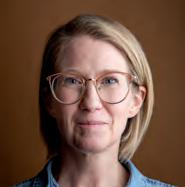
217 N. Broadway
Why its wine list is poetry: In the Third Ward, Bavette consistently offers a terrific, bistro-style list that strikes a smart balance between classic producers and wildly fun contemporary ones from around the globe. A glass of Manzanilla Sherry with their glorious charcuterie board makes day drinking hard to resist.
Who curates the wine list?: Karen Bell, owner.
What else does she do at the restaurant?: “My responsibilities cover the gamut,” says Karen. “I am hands on with both the food and beverage menu, as well as the day-to-day operations.”
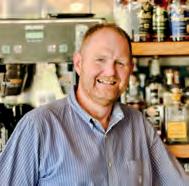
STORY HILL BKC:
BOTTLE - KITCHEN - COCKTAIL
5100 W. Bluemound Road
Why its wine list is poetry: Story Hill BKC deserves recognition for its discreet in-restaurant bottle shop, where diners can purchase wines at retail prices and enjoy them with their meal for a modest corkage fee.
Who curates the wine list?: Jason Kerstein, director of operations and beverage director.
What else does he do at the restaurant?: His lists of responsibilities include, but aren’t restricted to, staff management, financial management, menu development and promotion and marketing.
Gaetano Marangelli is a sommelier and playwright. He was managing director of a wine import and distribution company in New York and beverage director for restaurants and retailers in New York and Chicago before moving to Wauwatosa.



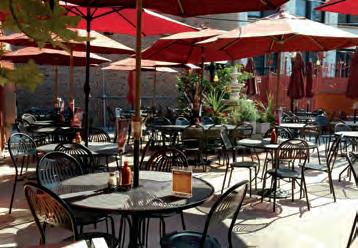
BOTANAS RESTAURANT
816 S. Fifth St. Milwaukee (414) 672-3755
Botanasrestaurant.com
In the summer, sip margaritas and munch on chips and guacamole on Botana’s open-air patio. It’s spacious enough for large groups and also perfect for a table of two. If the outdoor seating is full, request a table under the covered patio to still take advantage of a summer evening. Both options are a great way to enjoy this casual cantina that offers authentic Mexican dishes.
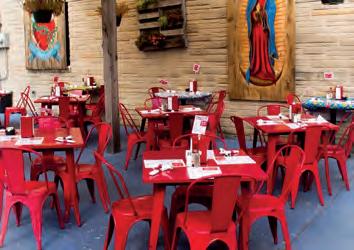
CAFÉ CORAZON
Multi locations in Bayview, Riverwest & Brown Deer Corazonmilwaukee.com
The Riverwest location along the Beerline Trail complements the restaurant's bright, fresh Mexicaninspired food. In Bayview, you'll find a quiet, artsy patio tucked away from the hustle and bustle of Kinnickinnic. The Brown Deer location hosts the largest Corazon patio with seating for 60. It too is off the Oak Leaf Trail and features its own outdoor bar.

CAFÉ MANNA
3815 N. Brookfield Rd. Brookfield (262) 790-2340
Cafemanna.com
Enjoy this summer season at our neighborhood gem located off of Capitol Drive. Sit, socialize and indulge in Manna’s craft cocktails and exciting vegetarian/vegan summer cuisine.








CENTRO
808 E. Center St.
Milwaukee (414) 455-3751
Centrocaferiverwest.com
An Italian-inspired, full-service restaurant with delicious food, warm service, and a charming atmosphere… seasonal deck and sunken garden terrace dining … exceptional dining experiences to remember…bar centro jazz lounge next door.
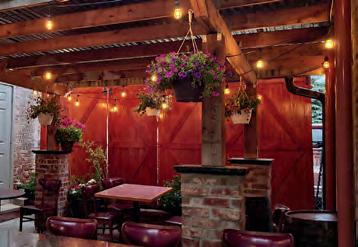
FIVE O’CLOCK STEAKHOUSE
2416 W. State St.
Milwaukee (414) 342-3553
Fiveoclocksteakhouse.com
Relax and enjoy your supper club experience on our intimate patio lined with beautiful flowers and firepit. Five O’Clock Steakhouse specializes in serving award winning steaks and seafood paired with a notable wine list, classic cocktails and outstanding personalized service.
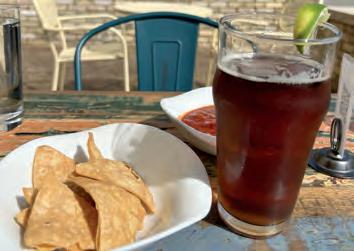
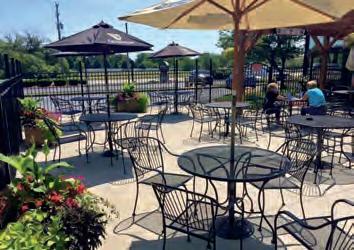
Enjoy lunch or dinner on our beautiful, spacious smoke-free patio that is perfect for private parties and large groups. You can also catch live music on the patio, weather permitting.

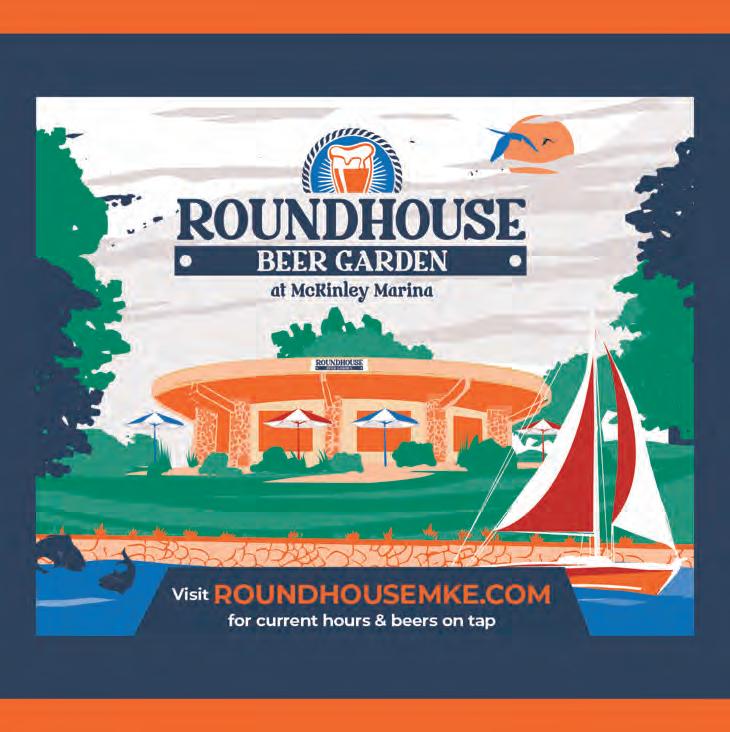



ROUNDHOUSE BEER GARDEN
AT MCKINLEY MARINA
1750 N Lincoln Memorial Dr
Milwaukee
(414) 395-4909
roundhousemke.com
An updated venue serving all those drawn to this freshwater coastline. Serving up snacks, drinks and sundries, it’s your one-stop shop before setting sail. Not heading out on the water? Food and drinks purchased at Roundhouse Beer Garden can be enjoyed on the comfortable parklike lawn surrounding our building. Drinking at Roundhouse Beer Garden at McKinley Marina supports future Milwaukee County park projects.

2613 E Hampshire St. Milwaukee
(414) 964-2611 saladining.com
SALA, on a quiet street off Downer, where the patio offers a relaxing European atmosphere. You will find it perfect for a morning coffee and fresh pastry, a midday panini or a delicious evening dinner with a bottle of wine or a cocktail under the umbrellas. You may feel like you're enjoying an evening in Palermo or Rome. Contact us atsaladining.com.

1503 N. Farwell Ave.
Milwaukee
(414) 276-8867
pastatreemilwaukee.com
Tucked behind The Pasta Tree, our enchanting Secret Garden patio glows with twinkling lights, lush blooms, and romantic charm—Milwaukee’s most magical dining escape.









BY CARI TAYLOR-CARLSON
his year we’re focused on locally owned establishments that have been around for a few years and have left a positive mark on our city, becoming gathering spots in their neighborhoods and destination points for all Milwaukeeans.
1201 S. Second St. (414) 272-2233
ApolloCafe.com
Named for the Greek sun god, solar designs are worked into the café’s floor and tabletops; the sky-blue high ceiling flecked with white clouds, gives the compact space an airy dimension.
The Hellenic modern aesthetic of the family-owned restaurant extends to the menu. Entrees involve all major food groups; vegetarians will find many delights. The café affords patrons the leisure for good conversation or a place to sit and watch as the Brady Street traffic rushes past. (David Luhrssen)
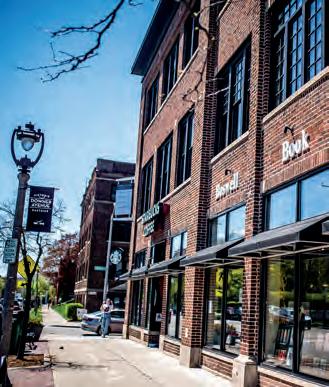
2559 N. Downer Ave. (414) 332-1181
boswellbooks.com
Back in Y2K, the futurists proclaimed the death of retail bookselling but turns out that shopping at a bookstore is more fun for most people than ordering from Amazon. Filling the space long occupied by Schwartz Books, Boswell became Milwaukee’s flagship for independent booksellers with a thoughtful selection, a commitment to Milwaukee authors and an active schedule of author talks and signings. (David Luhrssen)
801 E. Clarke St. (414) 312-8742 falconbowlmke.com
Built in 1882, the Falcon Bowl was sold in 2021 to the non-profit Riverwest Investment Cooperative. Lyn Okopinski’s husband began running the place almost 40 years ago and she retired in June of ’22. New ownership has continued the tradition of being more than a corner tavern--the space includes bowling in the basement and plays host to a wide variety of live music in the spacious hall and cozy Falcon Nest. (Blaine Schultz)
2136 N. 21st St.
Alice’s Garden is a community green space that brings regenerative farming and agricultural education to the heart of Milwaukee. The “Labyrinth Walk” at the garden encourages meditation and mindful healing with nature while the Herbal Apprenticeship Program supports herbal education and agricultural enterprise. The nonprofit also partners with local businesses and organizations to provide a variety of family and environmental programs throughout the year. (Caroline Dannecker)
6141 N. Hopkins St. (414) 527-0232
One of Milwaukee’s best kept secrets is a 237-acre green space located within city limits. Wisconsin's only urban state forest, Havenwoods State Forest boasts more than six miles for hikers and runners with two miles open to bicycles.
In the 1800s the land became a settlement and farmland; in the early 1900s Milwaukee County House of Correction prisoners tended crops, milked cows and constructed furniture in the Granville Chair Factory. In 1945 the U.S. Army used Havenwoods to house soldiers and prisoners of war—it was also a Nike missile base. But in the mid-‘70s nature began reclaiming the land. Seeds from surrounding trees sprouted and grew. As a result, thousands of trees and shrubs flourish in the wooded parts of the property. Mother Nature always wins. (Blaine Schultz)
HENRY & BONNIE'S BUNGALOW RESTAURANT
3466 N. 14th St. (414) 265-0155
It's a relaxing, comfortable setting for the comforting cuisine some call soul food, especially when comes from African American cooks with a heritage originating beneath the Mason-Dixon Line. Whatever one wants to call what's served at the Bungalow, it's so longlived a Milwaukee institution that it has developed its own heritage. The Bungalow celebrates its 50th anniversary in 2025, making it one of the city's oldest continuously operating eateries, for soul food or any other fare. (Jamie Lee Rake)


6901 W. Oklahoma Ave. (414) 541-7777
sciplus.com
Beloved by educators and hobbyists, the American Science and Surplus location on Milwaukee’s South Side is the largest store in the Midwest chain.
Having originated as a catalogue selling science supplies and army surplus (postWorld War II), American Science and Surplus has never strayed far from its roots, offering everything from beakers and telescopes to whoopie cushions and tank sights. (Caroline Dannecker)
2501 S. Delaware Ave. (414) 481-8030
atrandommke.com
Even during the middle of the last century, At Random must have seemed like a midcentury time capsule, a fantastic replication of the sort of lounge off the main drag in Vegas where Frank and Dino might retire for a Brandy Alexander.
The interior is dimly lit and distant from the bustle of the outside world. In the mood for anything with alcohol and ice cream, or something red hot and flaming? You can find it here. Recent updates include a beautiful patio. (David Luhrssen)
5811 W. Vliet St. (414) 305-7766
The idea for Charles E. Fromage comes from 18th-century French salons—places where people gathered to discuss literature, art, current events, and ideas. The cozy mid-block hideaway offers craft cocktails and an impressive wine list. While the summer rooftop music series is on hold, the roof seating still offers a great view of West Vliet—especially for the July 11 Bastille Day West celebration. (Blaine Schultz)
5020 W. Vliet St. (414) 982-5020 livedandy.com
Packed with tables, lamps, artifacts and oddities, racks of vintage clothing … Dandy is the sort of cool resale store the East Side once had before all those rents went up. The atmosphere is so striking that Milwaukee Opera Theatre chose Dandy as the site for their performance of a Baroque opera, Handel’s Alcina. The uniquely configured shop is available for weddings, parties and gatherings of all sorts. (David Luhrssen)
Milwaukee is home to many more hidden gems! Read all about them ShepherdExpress.com

Scan to Read about more neighborhood gems.








BY DAVID LUHRSSEN
Milwaukee doesn’t have the skyline of Shanghai or Manhattan, nor is it home to the world’s tallest building, but it is the envy of many heartland cities for its architectural heritage. Here are 12 landmarks that represent Milwaukee history and its enduring presence as a major city.
1201 S. Second St.
For the longest time, it was the largest four-sided clock in the world—America’s Big Ben, overlooking an industrial district that in recent years has become a thriving home for restaurants, businesses and urban living.

ORTHODOX
9400 W. Congress St.
Frank Lloyd Wright was Unitarian, but the Wisconsin master made an exception for this wonderful sanctuary in the round, a structure fully Byzantine and fully modern set on the edge of the City of Milwaukee. Completed in 1961, it was Wright’s final project.
N. Riverwalk Way
(just south of Wells Street)
Milwaukee’s most popular public artwork is a bronze statue depicting Milwaukee’s most popular fictional resident, “Happy Days’” Arthur Fonzarelli aka “Fonzie.”
He stands alongside the Milwaukee River, giving his familiar thumbs up.
HISTORICAL DISTRICT
2732-34 W. Burnham St.
Frank Lloyd Wright is remembered for his modern mansions, but he was also concerned with bringing good architecture to ordinary people. One of the best examples is the block-long row of American System-built homes erected from prefabricated materials.
135 W. Wells St.
Built to house the headquarters of Milwaukee’s German-language press, the 1896 Germania Building features a set of copper domes shaped like the pointed helmets of the Prussian military. The former office building has been revamped into Downtown apartments.
The Hoan Bridge spans Milwaukee Harbor with gleaming arches, linking Bayview and the South Shore with Downtown and points beyond. More than just a link in the interstate system, the Hoan lights up in different colors on selected nights—blue and gold on Opening Day, blue and yellow for Ukraine ...
700 N. Art Museum Drive
The museum gained international acclaim in the ‘90s for its winged addition by Spain’s Santiago Calatrava, but don’t forget its original footprint in a gem of ‘60s modernism, Eero Saarinen’s Milwaukee County War Memorial.
200 E. Wells St.
Built in 1895 and soaring 15 stories, Milwaukee’s City Hall was the Southeast Wisconsin’s tallest structure until the 1973 opening of the First Wisconsin Center (now Baird’s headquarters). The architect wasn’t chosen after a nationwide search but was a Milwaukeean, Henry C. Koch, who designed the building as a taller, reach for the sky version of town halls in his native Germany.
524 S. Layton Blvd.
Milwaukee architect Donald Grieb had Buckminster Fuller in mind when designing the three glass beehives that comprise the Mitchell Park Conservatory. Built from the late ‘50s through ‘60s, the Domes are the home for flowers, desert fauna and tropical plants that flourish year-round.

144 E. Wells St.
One of the oldest continuously working theaters in the U.S., the Pabst was built in 1895 with beer-baron money and hosted performances by Sergei Rachmaninoff and Laurence Olivier. In recent years, the Pabst has been one of the city’s active concert venues.
2333 S. Sixth St.
The magnificent edifice on the city’s South Side was patterned after St. Peter’s in Rome and built at the start of the 20th century using building materials salvaged from a demolished Chicago post office, hauled to Milwaukee on flatbed freight cars.
626 E. Wisconsin Ave.
The handsome Art Deco skyscraper is unique for being topped by a glass flame beacon that changes color to forecast the weather—red for warmer temperatures, gold for cold, flickering for precipitation and blue for “no change in view.”



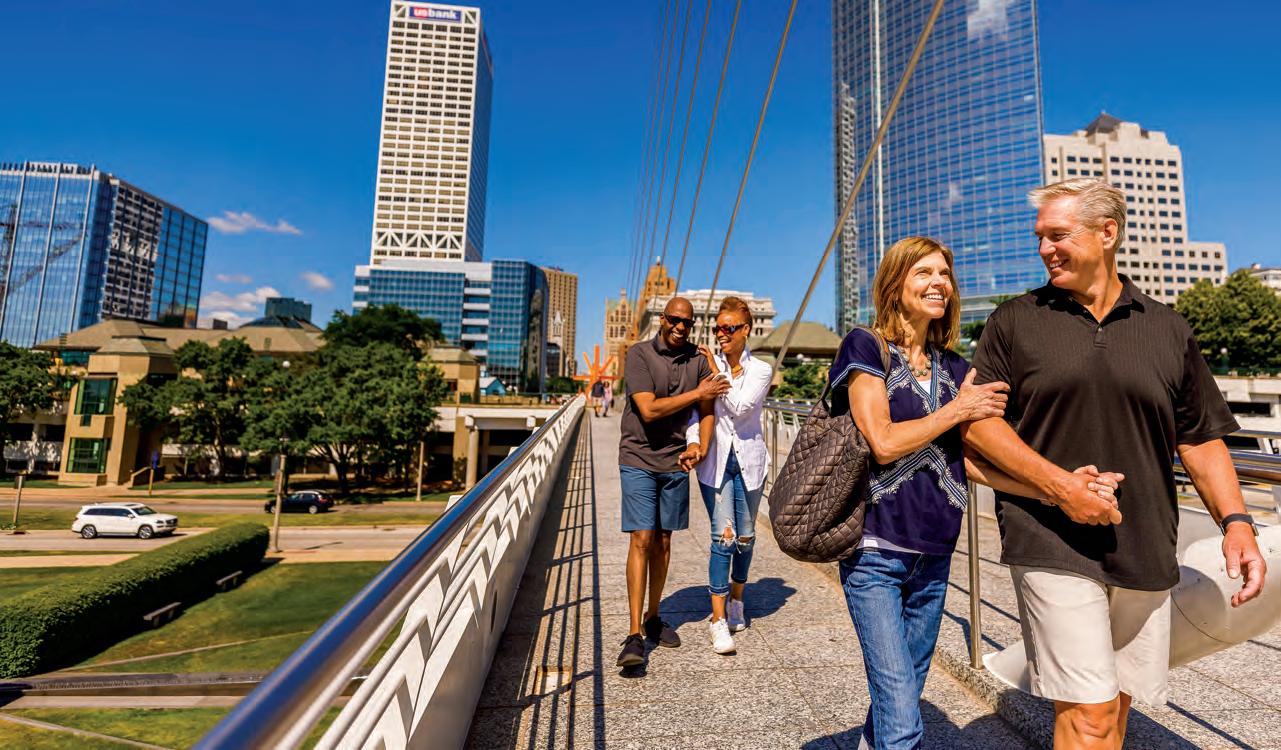
BY CARI TAYLOR-CARLSON
Agood way to explore Milwaukee is on foot, neighborhood by neighborhood. You can reach out and touch the buildings, walk on the beaches, shop in the shops, eat in local restaurants, and walk in the parks. The list of potential walks is endless and Milwaukee’s colorful history, filled with wave after wave of hardworking immigrants, remains visible today in our neighborhoods. The early settlers are long gone, but they left many traces behind, for example their Polish flats in the Riverwest neighborhood.
Riverwest might be the most diverse neighborhood in Milwaukee. It is also a neighborhood where many ethnic settlers came to work, planted roots and stayed for generations. The Germans came first in the early 1800s, followed by Polish settlers in the 1880s. Those frugal Poles built their homes to accommodate two families, and these homes became known as Polish flats. You will recognize them by their steep exterior staircases that lead to a second-floor residence stacked on top of a ground level residence.
As you walk around Riverwest, you will see many “flats” and cottages as well as some more elegant homes on Humboldt Boulevard. A good place to start is the Uptowner Bar at the corner of Center Street and Humboldt Boulevard. Nearby you will see Our Lady of Divine Providence Church on Clarke Street. Also nearby is the Riverwest Co-Op, a natural foods store and café located in a former Schlitz tied house.
When you come to Locust Street, look for Black Husky Brewery and if you wish, bring your dog. If you want something to eat with your brew, you are welcome to bring it yourself.
Just west on Locust Street, Woodland Pattern Bookstore promotes poetry and books from independent publishers.
If you head north on Bremen Street, you will pass many Polish flats as well as cottages and duplexes and just before Burleigh Street, you will come to Snail Crossing Park named for a quilt pattern that represents the blend of ethnic groups in Riverwest. There is a lot more to explore nearby--check out the shops, restaurants and bars where anything goes, the people are friendly, and the vibe is cool.
Brewer’s Hill, located south of Riverwest, is filled with majestic homes built by wealthy brewers and North Avenue merchants. There are also an equal number of small cottages formerly owned by the brewery workers and the men who worked the tanneries and the sawmills adjacent to the river. As businesses left the area, many of these homes were demolished or left to crumble. A renewal, led by the Historic Brewer’s Hill Association, has reclaimed and renovated many of these Victorian homes and small cottages, and today Brewer’s Hill is an integrated neighborhood with a mix of incomes, lifestyles, and homes.
A leisurely stroll is the best way to appreciate this collection of restored homes. You could start this walk at the Kinship Café at 2153 Dr. Martin Luther King Jr. Drive, a community hub located in the former Gimbel’s department store. When you leave the café, cross MLK and head east on Lloyd Street where you will enter Brewer’s Hill. When you get to Palmer Street, walk down the hill to 1823 Palmer to see the Sanger House Gardens, a spectacular display of more than 400 varieties of trees, shrubs, perennials, and annuals.
If you want to see more after you have traversed the streets of Brewer’s Hill, walk east on North Avenue and cross Holton Street. Soon you will come to Kilbourn Reservoir Park. There are several routes to the top of the hill where a reservoir operated until 2004. After it was removed, 88,000 cubic yards of soil were trucked in to replace the former reservoir and the addition of grass, trees, and shrubs, turned it into a park where you will find what many consider the best view of the city in Milwaukee.
When you look south from the park, you can see St. Hedwig’s steeple, a Brady Street landmark that rises 160 feet above the sidewalk. It was a center for the early Polish who came to the Brady neighborhood to work in the industries along the river.
Before you start to walk on Brady Street, take a long view and you will see a jumble of architectural styles and a tapestry of bars, shops and restaurants. If you want to take in all the commercial activity on the street, start at the west end at Sticky Rice, a small Thai restaurant, and head east. You will pass Casablanca with its Mediterranean cuisine and the Diplomat where chef Dane Baldwin is a James Beard Award winner. Then you will come to Glorioso’s Italian Market, St. Hedwig’s Church, Peter Sciortino Bakery, and finally Art’s Smart Dart Mart at Humboldt and Brady.
East of Humboldt, multiple bars and restaurants dominate the street including Sweet Joy Café, Twisted Plants, a vegetarian restaurant, La Masa where they serve baked empanadas, and two franchises, Qdoba and Jimmy John’s. Just beyond Walgreens, look for the vacant triangle-shaped lot on Farwell Avenue where there will soon be an 11-story, 130-room hotel.
There is more to see in the neighborhood when you leave Brady including Pitch’s known for BBQ ribs, Wolski’s Tavern, many Polish flats, vintage Cream City brick homes, and Caesar’s Park on Boylston Street.
At the park, concrete steps lead to the river and a path that will take you along the river to the Urban Ecology Center and beyond. This is also the site of the former North Avenue Dam and a fine place to linger far from the hubbub of Brady Street.
The Downer Avenue and Newberry Boulevard walk is less a neighborhood walk and more of a saunter up and down two streets plus a foray into Lake Park. Downer, from Webster Place to Newberry, is pure East Side where sidewalk seating and people watching are popular warm weather activities. This is a fine walking street where the ghosts of Ma Jolie and the Coffee Trader have been replaced by Belgian beer at Café Hollander, escargot at Pizza Man, baguettes and boules at Breadsmith, and a Vanilla Latte at Starbuck’s. You can pick up a scone at Stone Creek Coffee, toilet paper at CVS Pharmacy, buy a screwdriver at Downer True Value Hardware, purchase groceries at Sendik’s, or sink into a comfy chair at Boswell Book Company.
At the north end of this commercial strip, turn right on Newberry where you enter a parade of homes on an elegant boulevard known for its mature maple trees and grassy median.
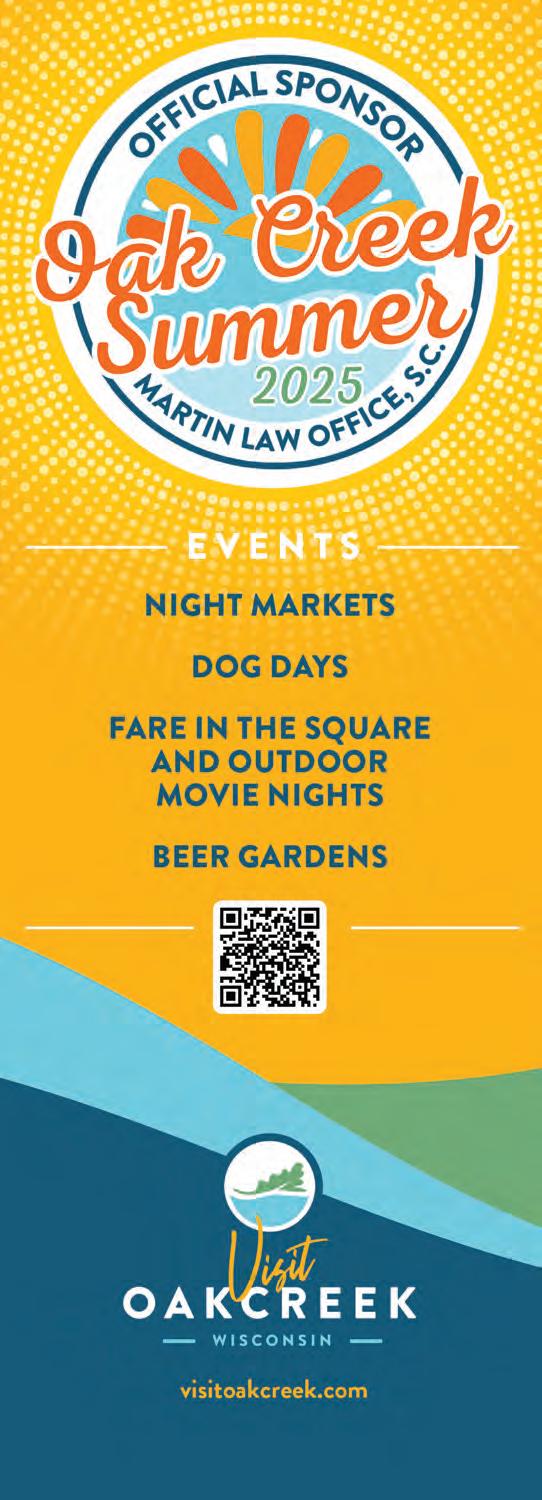
To fully appreciate the beauty and architectural diversity of the homes on Newberry, walk the entire 12 blocks from Lake Drive to Oakland Avenue. This is the promenade that Frederick Law Olmsted envisioned that would link Riverside Park and Lake Park. At the corner of Lake and Newberry, you will see one of Milwaukee’s largest homes surrounded by a magnificent wrought iron fence. At 2727 E. Newberry, note the gables and turrets that adorn this home with 17 rooms, seven bathrooms, and eight fireplaces. In summer, take a moment to admire the garden surrounding the home on the northwest corner of Newberry and Stowell Avenue.
You can extend this neighborhood saunter by crossing Lake Drive at the east end of Newberry and continuing into Lake Park, also designed by Frederick Law Olmsted.
The North Point neighborhood, south of Lake Park, is a showcase of early Milwaukeean’s prosperity as evidenced by the homes they built in the early 1900s. The neighborhood, now the North Point Historic District, sits on a bluff overlooking Lake Michigan.
A good place to start this walk is the top of McKinley Hill where the view of the harbor sheltering dozens of sailboats and yachts, as well as a clear view of Downtown, encourages a respite on one of the benches. From here you can head north on Terrace Avenue, and you will come to Villa Terrace Decorative Arts Museum. Keep heading north to see the Water Tower with its Gothic exterior covering an iron pipe four feet in diameter.
Many of the most interesting homes in this neighborhood are located on Terrace and Wahl Avenues. As you walk, note the gables, turrets, steep roof lines, helmet-shaped towers, sculptured terra cotta, and gargoyles.
When Jefferson Glidden and John Lockwood purchased 100 acres of empty land on a bluff overlooking Lake Michigan in 1854, they could not have imagined that their property would someday be the site of some of Milwaukee’s most opulent homes and become known as Milwaukee’s Gold Coast.
While Brewer’s Hill set an example of urban renewal in the 1970s, the same can be said about the Third Ward after a devastating fire in 1892 destroyed many of the homes built by the Irish, the ward’s early settlers. In 1976, when the Historic Third Ward Association was established, the city began to value the vintage buildings and warehouses left in the ward after the fire and one by one they were rehabbed and repurposed. Gradually the ward took on its current metropolitan personality and today it is filled with condos, shops and restaurants, instead of modest frame houses, warehouses and small manufacturers.
It is a fascinating area where you can spend an hour or a day wandering the streets and stopping to investigate shops and galleries. A good place to begin is the Public Market at the corner of St. Paul Avenue and Water Street where you could start with a cup of coffee from Anodyne and a cinnamon roll from C. Adams Bakery.
When you leave the market, look for the Marshall Building, a former warehouse built in the early 1900s that now houses small businesses and artists who want to combine contemporary amenities with vintage charm. It is also the home of the Shepherd Express
Also on Water, look for District Row, an upscale woman’s clothing boutique, and around the corner at Menomonee Street, Blick Art Materials. Walk east on Erie Street to see Catalano Square and across the street the Broadway Theater Center. Further north on Broadway, Broadway Paper is a longtime resident and a source of cards, gift wrap, and arts and crafts supplies. At 211 Broadway, Mod Gen, a contemporary general store stocks a multitude of gift ideas and across the street, Retique sells carefully curated used fashions.
If all this shopping left your head spinning, head east on Erie Street toward the Hoan Bridge and around the bend you will come to Lakeshore State Park, which borders the Henry W. Maier Festival Grounds and Discovery World. Follow the paved trail, a lovely walk any time of the year and an appropriate way to conclude a whirlwind visit to Milwaukee’s Third Ward.
Unlike the North Point neighborhood, Bay View had a modest beginning. It first developed as an industrial suburb when Elmer Brock Ward established the Milwaukee Iron Company in 1868. Farmer’s fields were converted to neighborhoods and cottages were built to accommodate the workers at what became known as the Bay View Rolling Mill.
A good place to start is at the corner of Russell Avenue and Kinnickinnic Avenue at the Church of the Immaculate Conception. Travel east on Russell and look for Puddler’s Hall on St. Clair Street; Three Brothers restaurant on Conway Street; and on Superior Street, the Beulah Brinton Community House. Close to Superior on Russell, there’s G. Groppi Food Market with its upscale groceries, imported cheeses, and extensive wine selection.
A stroll down Superior from Russell to Oklahoma Avenue will take you through the heart of residential Bay View and give you a tour of the diverse homes in the village. At Pryor Avenue, you will find Milwaukee’s last public artesian well where you can fill a jug with iron-rich water. If you end at Oklahoma, you can continue walking south as far as you wish on the bike trail that follows the Lake Michigan shoreline.
The next time you are looking for something to do, lace up your shoes, choose a neighborhood, and get to know Milwaukee, one step at a time.
Cari Taylor-Carlson is the author of Milwaukee Walks: An Insider’s Guide to Historic Neighborhood Walks and Hidden Hikes.


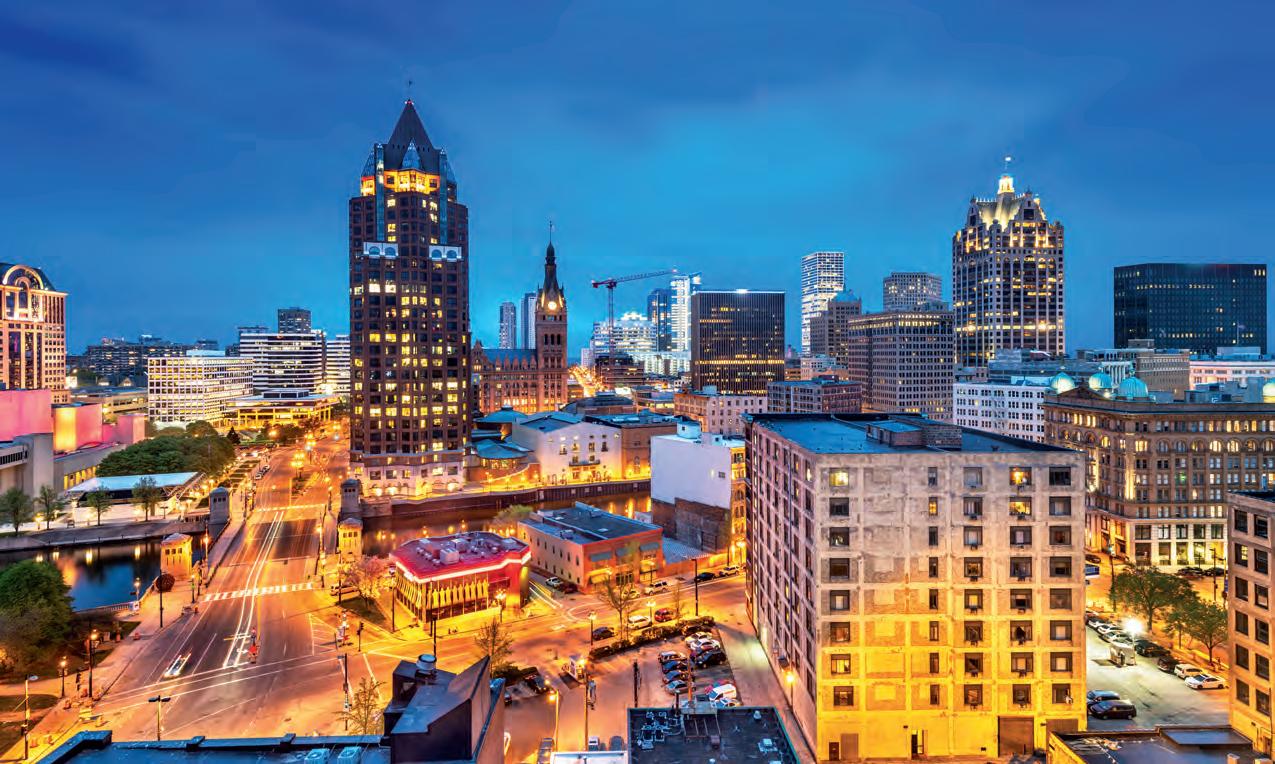
BY SHANE MCADAMS
t started as one more casual conversation between friends over drinks, but it led to a social reckoning. As a group of us poured back pricey cocktails, someone asked, “how many times have we gathered around a high-top table for three hours drinking Campari-somethings and intermittently picking at plates of bruschetta?”
Eventually someone burped out: “how much better would this conversation be, with the same drinks, the same food, and the same people … in a pet cemetery!?”
Apparently, there was a pet cemetery on Milwaukee’s North Side where people went to commune with the spirits of animals, fueled by the spirits from pocket flasks. Couples would go there on dates and sink into whatever strange magic they could summon.
We wondered, then, why do most of us choose string lights and stemware over seances with labradors? It was kind of a rhetorical question because pet cemeteries are a tall order. But, still, we wondered why we ended up in the same place over and over again?
In the cold light of day some weeks later I did a personal post-mortem about that exchange. I was proud of my work colleagues for recognizing their rut and thought I’d spend some time taxonomizing a better model on their behalf. I thought about where the mind met the body and where ambition met a good story. I decided to aim for a place somewhere between teenagers sneaking into abandoned warehouses and adults hardened by a world of hackneyed public relations messaging.
The obvious difficulty with such an exercise is that truly unique spots are often unpublic, and secret spots prefer to be kept secret. Or secret in a certain way; only for a certain exclusive set of ears and eyes. So please proceed through the following bag of suggestions with intrepid discretion.
If one aims high in New York or Paris, in Milwaukee one should aim low: Bars, brats, beer, bowling alleys, backyards and basements rather than velvet ropes.
More than once, I’ve redirected Milwaukee visitors from Old World Third to the intersection of East Russell and South Wentworth to explore the odd mix of culture, sights, people, and experiences in that eclectic pocket of Bayview. Throat metal at Club Garibaldi, alternative everything at Cactus Club, chicken thighs at Palomino, and frozen drinks from heaven at At Random. And Goodkind nearby to polish it off with some later-evening culinary refinement. And if senses are still wanting, Burnhearts down the way on Logan is a perfect goodnight kiss from the city.
As far as I know, it's an itinerary that has never disappointed.
Alternatively, Bryant’s on Lapham makes for one of the most perfect big-night ramp-up experiences one could want. The dark, velvety mood, the world class barkeeps, the balance of the drinks: always perfect. And it’s also perfectly strange that all this perfection happens where it does: in a non-descript house on Lapham and Ninth Street on the South Side. It makes the drinks and ambience all the sweeter. Another incognito gem that never fails is Foundation. It astounds any uninitiated visitor passing beyond its unassuming exterior at 2718 N. Bremen Street in Riverwest.

A trip from the sidewalk into the bar might as well be a 14-hour plane ride to a tiki bar in the South Pacific. Order a couple of planter’s punches and launch your night. Have a “oner” before dinner or have two and change your dinner plans. Have three and you might end up with a new tattoo. Not too far away, you can grab a cold bottle of Miller High Life and roll some frames at Falcon Bowl on East Clarke Street, one of the oldest bowling alleys in the country. If you’re lucky you can slide off your bar stool and see a band in the Falcon Hall just off the bar.
These establishments are, well, established, and might not be all that secret to veterans of the Milwaukee social scene, so let’s cut progressively deeper.
An often overlooked and somewhat obscure social opportunity is the art gallery opening reception. It’s a best kept offering within the world of artists that exhibitions almost always begin with a refreshment-filled two-hour opening event.
It’s a stimulating and economical way to rev up your synapses before a great dinner or theater experience. Milwaukee is stuffed with art galleries of all sorts, from very public spaces in the Third Ward like Portrait Society and Tory Folliard, to grittier below-the-radar haunts like Underscore, Usable Space, and Grove Gallery. Instagram handles happen to be the best way to stay informed about gallery goings-on as the art world tends to fly below conventional listings.
Art nerds know that reaching out to individual artists for studio visits can lead to unexpected connections, social energies, and, probably, beers, but if you happen to be a music nerd, do yourself a favor and go to ACME records on Kinnickinnic and peel through records until your fingers hurt. It’ll start as shopping and inevitably transition into a conversation with Ken Chrisien, the sagacious proprietor, about music, records, and the quirks of people who love them. Ken’s been selling vinyl for 20 years for the love of the game … and you’ll sense it. He’ll tell you why your mom’s Decca records are worth less than you think as he rhapsodizes with delight of finding mint copies of The Misfits’ Legacy of Brutality. With a few albums under your arm, head down KK to 2988 and punctuate the sonic orgy with a visit to the Wiggle Room, a listening lounge stocked with compendious vinyl and potable refreshments. You’ll leave satisfied and musically enriched.
We’re all familiar with legendary venues like Turner Hall Ballroom, the Pabst and Miller High Life Theaters, and the Rave. Milwaukee also sports a lively constellation of funkier venues like Mad Planet or Kochanski’s Concertina Beer Hall for a little Old World polka flavor. A little further south, X-Ray Arcade is a badass indie punk establishment on Packard Avenue in Cudahy whose existence reaffirms that there are still warriors for alternative sonic culture living among us— with arcade games and art exhibitions to boot. You can even host your wedding reception there if you’re tough enough to face your mother-in-law afterwards. For some truly off-grid DIY stuff, Milwaukee is home to many underground-ier music spaces, literally in basements, such as Down on Downer and Discastle.

Be careful, you might have to knock and you might very well be the oldest person who’s ever been there.
If you’d like to begin an experiential journey with some black-diamond-level shopping, stop by the gift shop at 5 Points Art Gallery + Studios on Port Washington and then head down to 2445 N. Holton to the inimitable Fischberger’s Variety, where you will find the most nerd-perfect toycentric gift for the host of the dinner party to which you’ve reluctantly committed, and who’s only expecting a 20-dollar bottle of prosecco. Woodland Pattern, a nonprofit, bookstore and event space offers unique artwork and books in a cocoon of local collaborative warmth that will make you want to stop what you’re doing and pen some poems.
After dragnetting Antiques on Pierce for all the Robin Yount fast food edition glassware sets from 1982 and 1970’s World Book encyclopedias, head to Hell-and-Back, a vintage store located on Second Street beneath Var Gallery for anything from a vintage Motley Crüe concert t-shirt to a 1970’s cowboy belt buckle that may have been worn by Jerry Reed. If you have gas in the tank and a love of inexplicable oddities, take a drive down to Cudahy, go to Dretzka’s, and try to figure out what that whole thing even means, while concluding that you really need an unworn factory uniform for a job that disappeared 30 years ago.
Ambitious hands-on types might heighten their levels of existential engagement with more participatory and relational activities. These are the events that will leave you feeling you’ve merged action and passion into a single piece. Come home with paper cuts instead of ketchup fingers. A great opportunity is Var Gallery’s regular drink-and-draw event on Monday, Wednesdays, and Saturdays, where you can sketch from a live model while having a cocktail. Bring paper, charcoal, and a total lack of inhibition. Don’t worry if you’re not an expert, no one’s judging, and life drawing is like speaking a foreign language, one gets better with consumption.
Out in West Allis, the delightfully quirky lair of Madam Chino hosts a last-Friday-of-the-month Community Patchwork Sewing Circle. Have some tea, learn how to sew, and sink into the plush awesomeness of the whole fibrous thing. Just being in Chino’s coven of textile goods and sewingcentric vibrations will make you want to have a nightcap with just as much color and creativity. Inspiration is infectious … and cross disciplinary.
Milwaukee is exceptionally rich in artist and maker workshops for discriminating tastes. It’s where our DIYheavy community thrives, and it offers great opportunities to connect with other creatives and alternative methods. Also, productivity often ramps up into a decadent second half of an evening. Like how a good run makes a bowl of pasta feel less naughty.
AP3 at House of Rad offers regular printmaking workshops, the Bindery in Bayview will take you on any number of hands-on voyages with bookmaking that will transform you into a connoisseur of bone folders, and Tooth-and-Nail Studios in the Lincoln Warehouse will have you looking to acquire a pottery wheel and kiln. And there are far worse addictions than cone 6 pottery.
Those mentioned so far are all established spaces meant for your regard and participation. Shaping experience sometimes demands an even more informal playbook–sites and activities waiting for you to activate them.
A good beginner-map for such an adventure might be Sculpture Milwaukee, which features an actual map of hidden artistic 3D treasures situated within our Downtown urban terrain. From this basic set of possibilities one can build their own private hike. While speaking to Sculpture’s Executive Director John Riepenhoff, he suggested a morning coffee inside Sarah Braman’s Stay, a converted drainage pipe with stained glass windows, while watching the sun rise over the art museum. Which I did, and it was glorious. The Flat Files at Real Tinsel, of which I am a partner, offers the chance to listen to a record, have a drink, and privately search through hundreds of portfolios featuring original work by local artists at your private leisure.
Taking off the training wheels, one can ride the Milwaukee experiential tableaux even harder. Try freestyling a little. Have a multi-couple custard taste-off by driving from famous custard stand to famous custard stand evaluating each as if you were doing the Pepsi Challenge. I hosted a potluck some years ago in which each dish was made from items purchased from the guests’ nearest Kwik Trip. It wasn’t the tastiest dinner party, but it might have been the most fun. We did have to grab pizza at Classic Slice afterwards to wash down a corn nut and rollerdog casserole. For cosmic vibrations, try microdosing and heading to the Manfred Olson Planetarium at UWM. It’s not a bad way to spend a random afternoon, and you just might connect with a higher power. For more terrestrial mycelic entertainment, you could drive north of Milwaukee to the Cedarburg Bog State Natural Area just west of Saukville with a mushroom and plant identification app on your phone. Bogs, moraines, and dells are just a few of the unique landscape features in our region offering flora, fauna, and vistas not found anywhere else.

On the way back from bogging, stop by Brandywine in Cedarburg for the best appetizer you’ll ever have while looking down a street pulled straight out of a Currier and Ives print.
If it’s still light out, you might detour to Schlitz Audubon and say hi to Skywalker the falcon or go climb the tower to grab a perfect view of Lake Michigan. Another fine option for adults and children alike is an art scavenger hunt at Lynden Sculpture Garden just to the west of Schlitz Audubon on Brown Deer Road. On the way back to Milwaukee, take a quick detour to the legendary Mary Nohl House in Fox Point. But be quiet and stealthy, the neighbors are sleeping… and vigilant. Sometimes before heading out, I stop by the Milwaukee County Historical Society and check out a folio of images of one of our streets from the early 20th century. You can name a street, and a librarian will hand you a glassine folio filled with vintage photographs … and then go have dinner on that street.
Your night will feel 100 years long and that many years young. And maybe finish the same evening with a sip of something weird right under the lights of the Hoan Bridge and put the city to sleep for the rest of us.
You didn’t hear it from me but in 2019 the Wisconsin legislature passed a bill that allows for minors to operate a lemonade stand as long as the revenue is under $2,000. So if you have kids, set one up on a corner and use it as a way to engage passersby in conversation. You will not be disappointed.
Then take the money you collect, hire a babysitter, and aim your Uber to Walker’s Point to do some dancing at La Cage or Mad Planet for some sweaty dancing. If you have electrolytes left, dance some more at Riverwest’s Mad Planet.
And that pet cemetery is still there, by the way. Unmarked. I’m not saying where, or to go searching for it. But I’ve had worse nights than trudging through wet fields and backyards with good friends waiting to get bewitched by guinea pig spirits. Then again, there’s plenty of other magic around Milwaukee to ignite your imagination, so maybe let the souls of the animals rest and go paint an experiential picture worth its own urban legend that we’ll be telling each other over small plates in 20 years.
Shane McAdams is an artist whose work has been exhibited in New York, Portland and elsewhere. He has written for the Daily Beast and the Shepherd Express and was an adjunct professor at the Rhode Island School of Art and Design.

BY SOPHIA HAMDAN AND DAVID LUHRSSEN
ames Cameron was a Black man who narrowly survived lynching at the hands of a white mob in Indiana. Years later, he founded America’s Black Holocaust Museum (401 W. North Ave.) as a reminder of the nation’s uncomfortable history of race relations. In 2022, 16 years after Cameron’s death, the museum was reestablished in a new building in Milwaukee’s historic Bronzeville neighborhood. The museum tells the story of African Americans from the arrival of African slaves in 1619 through the present, using dramatic photographs, contemplative artwork and historical texts. The permanent exhibition follows the harmful legacies of slavery and Jim Crow in an effort to promote reconciliation.
The Charles Allis Art Museum (1801 N. Prospect Ave.) houses a vast collection of art from Sarah and Charles Allis. It offers an intimate, refined experience within the former family’s Tudor-style mansion. Each grand hallway or gallery reveals a hidden gem, with classical European paintings, intricate decor and period furnishings at the forefront. The Museum also hosts various exhibitions, educational programs and cultural events throughout the year. Guests are invited to participate in the creative process, with opportunities to engage in hands-on workshops. Whether you're an avid art enthusiast or a casual admirer, the Charles Allis Art Museum invites all to celebrate historical art.
Loved by families, dreamt of by kids, Discovery World (500 N. Harbor Drive) falls next under our list of must-see Milwaukee museums.
Through realms of science, technology and the natural world, Discovery World dives deep into an exploration of our deep sea, automation and beyond. With interactive exhibits like “Les Paul’s House of Sound,” hands-on experiments and live demonstrations, there’s endless opportunities to discover the extraordinaries of our universe in a familyfriendly environment.
Discovery World is special in that it emphasizes innovation, providing visitors with opportunities to not only learn about existing scientific concepts but also to experiment, create and innovate themselves.
The Grohmann Museum (1000 N. Broadway) on the Milwaukee School of Engineering campus was handed a unique job when it opened in 2007. The museum’s primary task is to display and preserve an extensive collection of paintings, photographs and sculpture depicting work of all kinds and industry in particular. A 1925 painting of men and women toiling inside a steamy workshop, Brooklyn Galvanizing Shop greets visitors, exemplary of the museum’s mission to display art representing all industries in every historical period. In recent years, the Grohmann has organized exhibitions of work by living artists concerned with America’s industrial legacy.
The Haggerty Museum of Art (234 W. Tory Hill St.) is a gem tucked away on the Marquette University campus, an institution with an impressive trove of art in its vaults and an admirably creative tradition of programming.


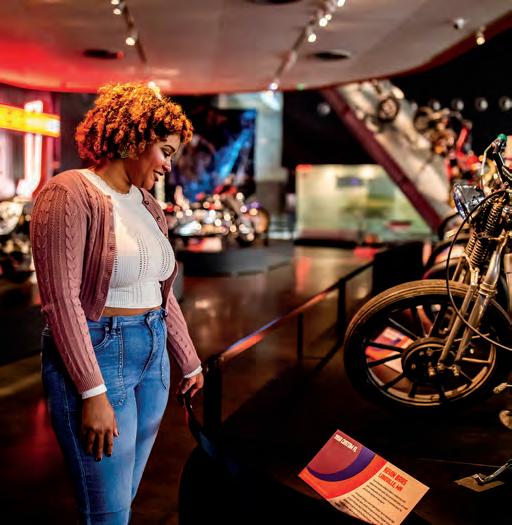
It’s a short walk between centuries at the Haggerty, where religious images and artifacts from medieval Western Europe might hang near kinetic sculptures and installations. The Haggerty mounts eight or nine exhibitions each year, often drawing from a rich permanent collection spanning many eras with a mission of reflecting on the contemporary world through the lens of visual art.
Milwaukee is home to The Harley-Davidson Museum (400 W. Canal St.), the heart and soul of American motorcycle culture. With Harley-Davidson founded in Milwaukee, you can imagine the rich history lodged within this institution.
Visitors can explore an unrivaled collection of vintage motorcycles, each one bearing a tale of legendary rides. Each exhibition highlights the evolution of HarleyDavidson’s famous designs and engineering marvels. Visitors can find themselves viewing memorabilia from over a century’s time, 1903 to the present. It’s one of Milwaukee’s top attractions for a reason, symbolic to adventure, innovation and freedom.
The Jewish Museum Milwaukee (1360 N. Prospect Ave.) mounts several exhibitions each year focusing on Jewish artists or aspects of Jewish history. However, each exhibit is an opportunity for insightful context through educational and community initiatives. The museum has hosted programs sparking conversations on the current political landscape, societal concerns, civil rights history, immigration, and other subjects. In keeping with the museum’s mission to link the past with the present, the recent exhibit “The Book Smugglers: Partisans, Poets and the Race to Save Jewish Treasures from the Nazis” included a Banned Book Nook featuring books that have been recently banned from libraries in the U.S. Among them, Harper Lee’s To Kill a Mockingbird.
Nestled on the shores of Lake Michigan, the Milwaukee Art Museum (700 N. Art Museum Drive) stands as a beacon of cultural richness in the heart of Wisconsin. Its renowned sculptural addition from Spanish architect Santiago Calatrava draws over 400,000 visitors each year. Inside, you’re met with diverse artistic expressions spanning centuries and continents.
Explore the vibrant colors of impressionist paintings, marvel at the intricacies of decorative arts and contemplate the thought-provoking installations of modern visionaries. But the experience doesn't end with the art alone. The museum's dynamic exhibitions, educational programs and engaging events invite visitors of all ages to delve deeper into the world of art expression.
The Milwaukee Public Museum (800 W. Wells St.) is a local favorite, home to over four million priceless objects and specimens. Each walkthrough is a testament to our wonderous natural history, with immersive exhibits spanning from the rainforests of Central America to the ancient civilizations of Egypt. Not to mention, visitors can embark on the Streets of Old Milwaukee, transporting you to our beloved city at the turn of the 20th century. This establishment explores a mixture of vast ecosystems and historical periods, offering a gateway through time and space. Whether you’re visiting as a local or outof-towner, the Milwaukee Public Museum promises an engaging experience that’ll surely foster your curiosity and appreciation for the natural world and human cultures.
The Milwaukee area is home to many other specialized museums including:
• Betty Brinn Children’s Museum , 929 E. Wisconsin Ave.
• Cedarburg History Museum , N58W6194 Columbia Road, Cedarburg
• Milwaukee County Historical Society, 910 N. Dr. Martin Luther King Jr Drive
• Milwaukee Fire Historical Society, 1615 W. Oklahoma Ave.
• Mitchell Gallery of Flight , Milwaukee Mitchell International Airport
• Museum of Wisconsin Art , 205 Veterans Ave., West Bend
• Northpoint Lighthouse, 2650 N. Wahl Ave.
• Pabst Mansion , 2000 W. Wisconsin Ave.
• National Bobblehead Museum , 160 S. First St., Second Floor
• Racine Art Museum , 2519 Northwestern Ave., Racine
• Villa Terrace Decorative Arts Museum , 2220 N. Terrace Ave.
• Waukesha County Historical Society & Museum , 101 W. Main St., Waukesha
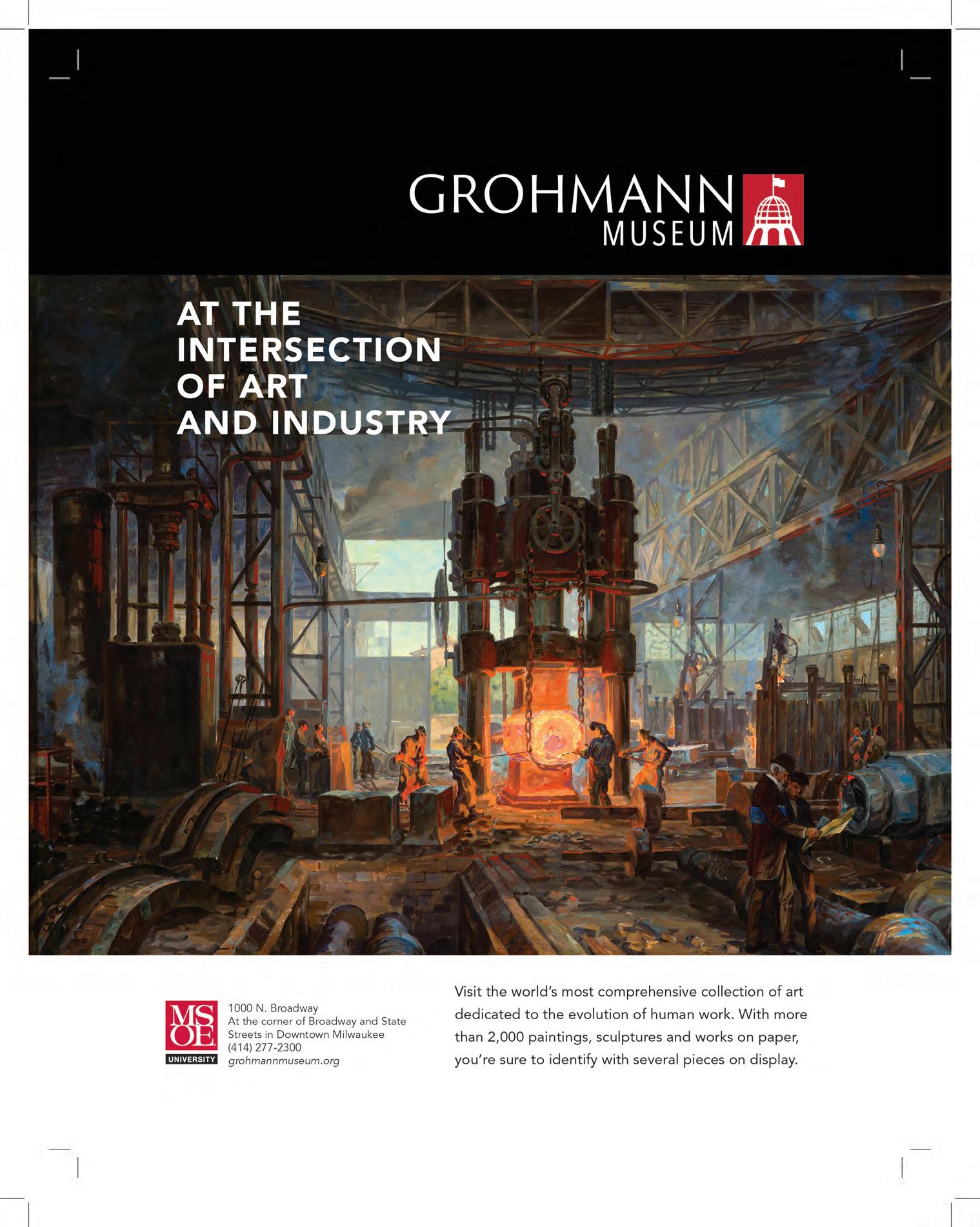


PBY SUSAN HARPT GRIMES
BY SUSAN HARPT GRIMES
otawatomi Casino Hotel has upped the game in so many ways. The remodeling project that began in 2022 has added new bars and restaurants, plus two new gaming areas. With the luxury hotel, excellent food and drink options, live entertainment, and all of the gaming options, visitors could easily spend a weekend getaway at Potawatomi and never have to leave.
If you like to take some risks and enjoy gambling, Potawatomi has a lot to offer. ElevenHundred Bar and Lounge, the gaming area on the second floor, with slot machines, gaming tables for blackjack, roulette and craps, plus electronic versions of blackjack and craps. Sportsbook is the huge state-of-the-art, Las Vegas-style retail sports betting space. How about that 14-table Poker Room? And of course, there is plenty of bingo for folks who prefer a lower stakes level of gaming. Whether you come out ahead or not, there are plenty of games to play at every level.
After you’ve worked up an appetite, there is no shortage of places to get a bite to eat. Go high-end and enjoy some fine dining at Dream Dance Steakhouse where you can get some of the best steak and seafood dishes in the city.
Or enjoy the flexibility of a quick nosh at the Potawatomi Marketplace, where you can choose between several tasty, but fast options at the Burger Company, the Taco Spot, the Gilded Cleaver, the Queen of Ramen and Project Pizza. Get delicious brunch food at the Canal Street Cafe, or authentic Asian at RuYi. Rock & Brews, opened in partnership with Gene Simmons and Paul Stanley from the rock band Kiss, serves American food with fun rock and roll names.
The Rock & Brews venue frequently showcases live music on Friday and Saturday evenings; ElevenHundred also offers entertainment on the second level. The Event Center, one of the largest venues in Milwaukee, has hosted music, comedy and MMA matches.
There’s so much to see and do in the Potawatomi complex a visitor could occupy themself for an entire long weekend getaway and still save more activities for another visit.
Susan Harpt Grimes is a Milwaukee writer and longtime contributor to the Shepherd Express.



BY LARRY WIDEN
“I'm just a square boy from Wisconsin”.
—Willem Dafoe
The Appleton native has appeared in nearly 150 films including Platoon, Spider-Man and Clear and Present Danger. After performing with Milwaukee’s Theater X, a 1970s avant-garde theater group he left to join several experimental theater companies in New York. “I was young and unsophisticated, but eager to train and perform,” Dafoe said. “I was totally involved and spent most nights on a couch in the theater because I was always studying and didn’t want to go home.”
Dafoe moved to Los Angeles and was cast in small film roles. His performance in To Live and Die in LA led to Mississippi Burning, Born on the Fourth of July and The English Patient
“I’m not ‘conventional’ looking,” Dafoe said. “As a result I’m usually cast as a bad guy.” He remains one of the hardest working actors in the business.
ALLAN “BUD” SELIG
Allan Selig attended Washington High School in the early 1950s with former Wisconsin Sen. Herb Kohl and film actor Gene Wilder. All three lived in the Jewish neighborhood of nearby Sherman Park. Selig was a baseball fan who followed the minor league Milwaukee Brewers at Borchert Field and later, the Braves when they moved to Milwaukee. After a stint in the Army, Selig sold cars at the family’s Ford dealership in West Allis. His love of baseball remained undiminished, and he invested his wages in the Braves team. By 1963, he was the largest public stockholder in the organization.
In 1970 Selig turned the bankrupt Seattle Pilots into the Milwaukee Brewers and became one of the game’s most influential owners. Thirty years later Selig was named Commissioner of Major League Baseball. He went into the Baseball Hall of Fame in 2017.
As a teenager, future Academy Award-winning actor Spencer Tracy spent much of his time fighting in the rowdy Irish neighborhood of Tory Hill. When he set fire to the family home, his parents enrolled him at Marquette High School. “I only went to school to learn how to read subtitles in the movies,” he said. Tracy went to Wauwatosa East before finally graduating.
Having been in school plays, he went to New York to be an actor. Tracy was surprisingly good and appeared on Broadway in a prison drama, The Last Mile. He went to Hollywood for John Ford’s crime picture, Up the River. Even as a successful actor, Tracy battled depression and insomnia by drinking. At times, he woke up in an alcoholic ward with no idea of how he got there. He won back-toback Oscars for Captains Courageous (1937) and Boys Town (1938). Spencer Tracy made 75 films during his career and died in 1967.
Writer, actor, and director John Ridley was born in Mequon to a successful ophthalmologist and a special education teacher. Ridley graduated from Homestead high school and then attended New York University. He became a stand-up comedian and appeared on the David Letterman and Johnny Carson late-night shows. Ridley also wrote for “The Fresh Prince of Bel Air.” His script for 12 Years a Slave won an Academy Award for Best Adapted Screenplay.
ROBERT BLOCH
One of the most prolific pulp magazine writers was Robert Bloch, who lived at 620 E. Knapp Street from 1929 to 1953. He sold stories to Weird Tales while still in high school. Bloch also wrote for Dime Mystery Magazine, Mammoth Detective, Thrilling Mystery and others. During his career, Bloch wrote more than 200 pulp stories, 30 novels and scripts for films and TV. His Psycho was inspired by the terrifying Ed Gein murders in Plainfield, Wis. The book was given to director Alfred Hitchcock, and his film is ranked #18 on the American Film Institute’s 100 Greatest American Films.
PETER STRAUB
Another horrormeister, Peter Straub, was born in Milwaukee in 1943. He attended Country Day School and became an English teacher at UWM. His novels, Ghost Story and The Haunting of Julia were made into successful films.
HATTIE MCDANIEL
Hattie McDaniel called Milwaukee “her springboard to Hollywood.” McDaniel was working as a ladies’ room attendant at Club Madrid, a roadhouse on Bluemound Road owned by gangster Sam Pick. One night when a performer was unable to go onstage, the management needed an act. McDaniel stepped in brought down the house singing “St. Louis Blues.” She performed at Club Madrid for two years, and then encouraged by myriad actors, politicians, sports stars and other visitors to the club, hopped on a bus to Los Angeles. McDaniel became the first person of color to win an Oscar, and it was for her role in Gone with the Wind.
JAMES LOVELL
In 1944 James Lovell attended Juneau High School and earned an engineering degree from UW-Madison. He went to the U.S. Naval Academy in Annapolis and joined NASA after graduation. To enter the Gemini and Apollo programs as an astronaut, Lovell studied spacecraft propulsion, orbital mechanics, astronomy, computing and space medicine. He made seven voyages into space before becoming the commander of Apollo 13’s mission to the moon in 1970.
“Houston we have a problem” was the catchphrase of Ron Howard’s 1995 film Apollo 13. An oxygen tank on board had exploded and the spacecraft was losing air. Lovell brought the module safely back to earth, setting a record for the farthest humans had ever traveled into space.
In Apollo 13, Lovell is played by Oscar-winning actor Tom Hanks.
DAN JANSEN
U.S. speed skater Dan Jansen was a favorite to win the gold medal in the 500-meter race at the Calgary Winter Olympics (1988). He fell in the race, having just learned his sister had died of cancer. Jansen suffered disappointment after disappointment in subsequent Olympic competitions before winning a gold medal in 1994.
GENE WILDER
Actor Gene Wilder was born Jerry Silberman and grew up on 44th and Burleigh and attended Washington High School. He studied communication and theatre arts at the University of Iowa. In 1955 he joined the prestigious Old Vic Theatre School in Bristol, England.

After a stint in the army, Wilder performed on Broadway, most notably with Kirk Douglas in One Flew Over the Cuckoo’s Nest. Wilder played the socially awkward Billy Bibbit, who suffers from PTSD. Around this time, Wilder discarded the name Silberman. In 1967 he was a Best Supporting Actor nominee for his work in The Producers
Wilder’s other film credits include Blazing Saddles, Stir Crazy and Willy Wonka and the Chocolate Factory. One of greatest commercial successes was Young Frankenstein, which he conceived and scripted.
Larry Widen writes about Milwaukee history for shepherdexpress.com.
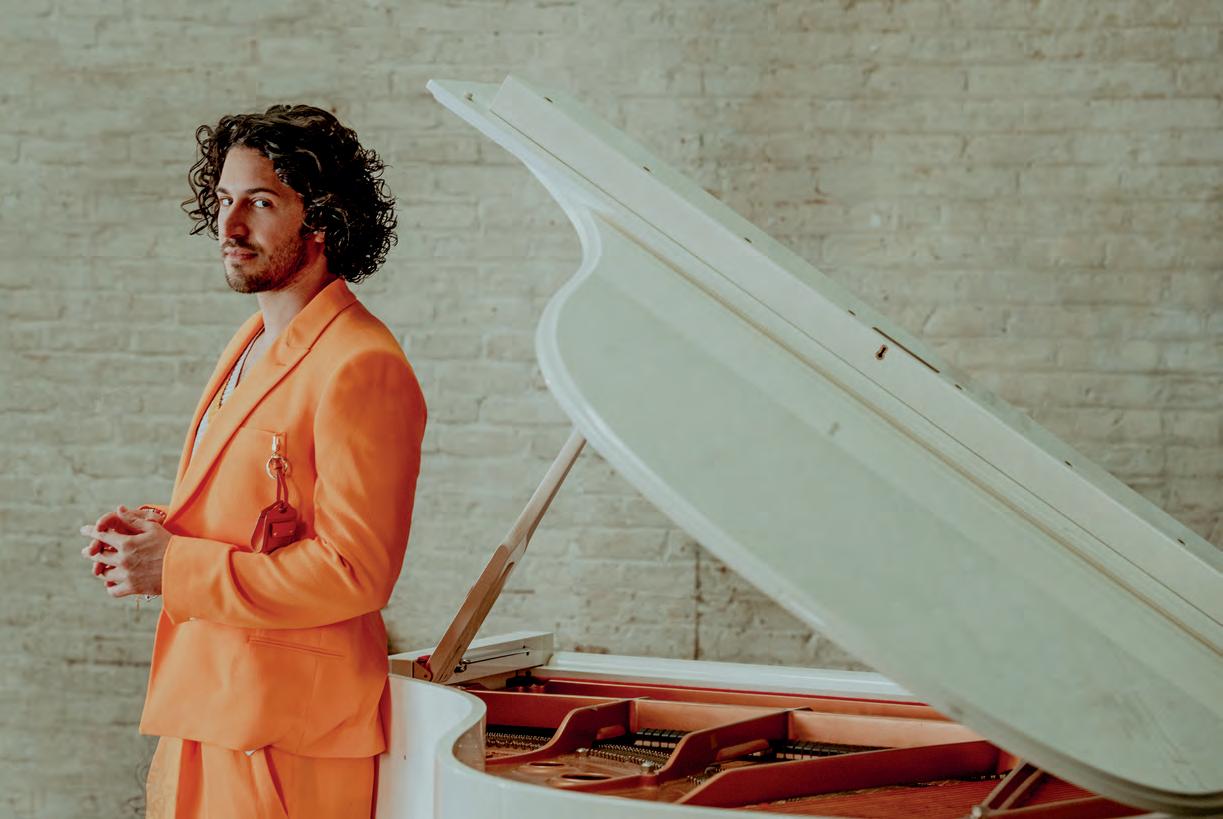
BY DAVID LUHRSSEN
aven’t been to the Sharon Lynne Wilson Center for the Arts lately? Or maybe never thought it was your kind of place?
The new artistic manager of the Brookfield performing arts venue has news for you. The Wilson Center dispensed with out of town (out of touch?) consultants and entrusted much of the 2025-26 season to Milwaukee’s Tyler Nikolas. He’s a guy with local roots, formerly general manager of a considerably different venue, the Miramar on Milwaukee’s East Side, known for EDM and alt-anything.
With his new job, Nikolas, 37, comes full circle. He studied vocal music at UWM, played in the chorus at Fireside Theater, and went to Shakespeare camp as a kid. Schooled in promotions at the Miramar, he’s bringing more of an indie sensibility to the Brookfield art center.
“I take our mission statement very seriously,” he says. “The Wilson Center is a vibrant destination, inspirational and educational.” The Wilson will continue to host matinees for seniors as well as productions for the Elmbrook School District. The Mainstage/Special Performance Series is where the changes come in.
“The Generation X-Millennial group has been somewhat neglected by the performing arts community,” Nikolas says. “We will always be multi-generational. I want to keep our base happy while attracting Gen X and Millennials.”
He cites Emmet Cohen, in concert at the Wilson Center on Feb. 27, 2026. The young jazz pianist will present an evening of Miles Davis and John Coltrane to honor the centennial of their births. The music is familiar to older jazz fans, but Cohen has a wildly successful YouTube series that has attracted interest from younger generations.
Nikolas adds, “Americana and bluegrass is music that connects multiple generations,” pointing to concerts by Marty Stuart (Oct. 24) and AJ Lee and Blue Summit (Jan. 16). But the season might commence on an edgier note with guitarist Julian Lage (Aug. 15), a onetime collaborator with New York composer-music shredder John Zorn.
To those who think the Wilson Center is far, far away, Nikolas says, “I live in Shorewood. It takes me 28 minutes down Capitol Drive to get to the Wilson Center. It takes 10 to get to Fiserv Forum, but then there’s parking. The Wilson Center sits in a beautiful park and has a big lot where you park for free. You can arrive five minutes before show time, get a drink before sitting down and enjoy the acoustics.”
And there are no hidden fees in the ticket price. Sixty-five dollars means $65, taxes included.
The Sharon Lynne Wilson Center is at 3270 Mitchell Park Drive, Brookfield. For more information, visit wilson-center.com.

BY JAMIE LEE RAKE
Here's
ALICE'S GARDEN URBAN FARM
2136 N. 21st St. alicesgardenmke.com
The North Side community planting space offers many free events.
BASILICA OF ST. JOSAPHAT
2333 S. Sixth St. thebasilica.org
One need not be Roman Catholic to tour and admire this imposing granite structure constructed for the Polish immigrants that flocked to the city's South Side.
BEACHES county.milwaukee.gov/EN/Parks/ Explore/Lakefront/Beaches
Not counting those in suburbs and outlying counties, Milwaukee has seven beaches, among them are McKinley Beach, Bradford Beach and South Shore Park.
BLACK CAT ALLEY blackcatmke.com
There is a portrait of a dusky kitty taking up some wall space, but there are other murals by artists to see for free at this outdoor gallery accessible on East Ivanhoe Place.
BOERNER BOTANICAL GARDENS
9400 Boerner Drive, Hales Corners county.milwaukee.gov/EN/Parks/ Explore/Boerner-Botanical-Gardens
Until October 30, it's free to see all the flora and such on the last Thursday of every month.
BOSWELL BOOKS
2559 N. Downer Ave. Boswellbooks.com
Most of the talks by authors whose works are sold at the East Side shop are without charge and hosted on premises.
HAGGERTY MUSEUM OF ART
1234 W. Tory Hill St. marquette.edu/haggerty-museum
The museum on Marquette University is “free and open to the public.” Exhibitions change regularly, and there are free special events on the calendar.
HANK AARON STATE TRAIL
hankaaronstatetrail.org
The bicycle and in-line-skate friendly walkway named for the home run champ runs 14 miles and connects to other, less lengthy trails.
JAZZ IN THE PARK
520 E Wells St. easttown.com/jazz-in-the-park
Every other Thursday from June to September, there are free concerts from 6-8 p.m. at Cathedral Square Park; a happy hour precedes the music. It’s one of several free outdoor music series, including Chill on the Hill, River Rhythms, Heart(beats) of the City, Musical Mondays and Washington Park Wednesdays.
LION'S TOOTH
2421 S. Kinnickinnic Ave. lionstoothmke.com
The Bay View bookseller and art space occasionally hosts author talks and, more regularly, a variety of book clubs dedicated to various topics.
LYNDEN SCULPTURE GARDEN
2145 W. Brown Deer Road, River Hills lyndensculpturegarden.org
Over 50 humongous sculptures reside on 40 acres that encompass park, lake and woodland geography, all free to see.
MILWAUKEE ART MUSEUM
700 N. Art Museum Drive mam.org
Admission is free the third Thursday of every month for everyone and always for attendees aged 12 and under.
MILWAUKEE CITY HALL
200 E. Wells St.
city.milwaukee.gov/cityclerk/Tours
Not every municipality has a city hall worth touring. But every second and fourth Wednesday until October 22 there are free tours at noon of the Flemish Renaissance Revival style building, bell tower included.
MILWAUKEE COUNTY ZOO
10001 W. Bluemound Road milwaukeezoo.org
There is usually an entry fee to enter this vast menagerie. There are, however, frequent promotions for everyone, or selected people (like dads on Father’s Day), to receive free admission.
MILWAUKEE CENTRAL LIBRARY
814 W. Wisconsin Ave. mpl.org
Not only is there plenty of free reading at every branch of Wisconsin's largest library system, Milwaukee Public Libraries host many free events and its main facility on West Wisconsin Avenue is an architectural marvel.
MILWAUKEE RIVERWALK
Citytoursmke/a-guide-to-milwaukeesriverwalk
Take a hike! Literally, there are plenty to sights to see without charge on this 20-block jaunt throughout the center of the city.
MITCHELL PARK HORTICULTURAL CONSERVATORY (THE DOMES)
524 S. Layton Blvd. mitchellparkdomes.com
It's free to tour the verdant landmark on the third Thursday of every month.
SCULPTURE MILWAUKEE sculpturemilwaukee.com
There's a high concentration of threedimensional public art in a stretch of about two miles, from Sixth Street to O'Donnell Park, numbering over 20 sculptures.
URBAN ECOLOGY CENTER urbanecologycenter.org
The nonprofit has three locations with a mission to encourage city dwellers to get outdoors. Many of their events are free.
WEHR NATURE CENTER
9701 W. College Ave. County.milwaukee.gov/EN/Parks/ Explore/Wehr-Nature-Center
It's always free to visit this facility at Franklin's Whitnall Park and the parking fee is waived on the last Thursday of each month.

BY JAMIE LEE RAKE
The Wisconsin State Fair’s Main Stage is a balancing act of tradition and surprise. This year’s headliners hew toward country, R&B, classic rock of various types and pop music old and new. It wouldn’t be the State Fair without comedy, children’s music and something for church-going folks. This year’s Fair covers all those bases with a lineup that should inspire many to splurge on more than general admission tickets.
THURSDAY JULY 31
Midland
7:30 p.m.
The Main Stage opens for 2025 with a bit of a wild card in Midland. Though signed to a major country label, the trio employ organic instrumentation and hard-living sentiments that position them more toward the music’s indie/ alt perimeters. The group members’ previous backgrounds in various aspects of showbiz have called their genre bona fides into question by some gatekeepers, but questions of Midland’s authenticity dissolve when their music is so genuine.
FRIDAY AUGUST 1
Boyz II Men
7:30 p.m.
To think of how dominant Boyz II Men were in the ‘90s is to be reminded of just how long ago it’s been since smooth, romantic male harmonies were prominent in soul and pop. Though the act has slimmed down from a quartet to a trio after their hit-making peak, their performances of slow jams and up-tempo bangers shouldn’t in any way suffer. And who knows? Maybe some young singers seeing them will be inspired to revive the style Boyz II Men took to such dizzying heights.
SATURDAY AUGUST 2
Ne-Yo
7:30 p.m.
Shaffer Smith gave himself a musical alias that reads like a Matrix character. But the only dystopia his songs address involves romantic matters. From the mid’00s to early ’10s, Ne-Yo regularly graced R&B and pop radio with odes extolling femininity, decrying his own romantic shortcomings, and hailing the good life singing has afforded him. His run of multi-format hits should prompt a wave of blissful nostalgia with his relatively innocent and respectful oldies.
SUNDY AUGUST 3
Queensryche, Great White & Quiet Riot 6 p.m.
Go figure that one of the lowest-price Main Stage shows this year is going to probably provide the biggest bang for a fairgoer’s buck. Between Queensryche’s progressive leanings, Great White’s glam proclivities and Quiet Riot’s working stiff aesthetic, this is a bill that encapsulates the gamut of ‘80s commercial radio metal prior to the explosions of thrash and grunge. Whether it’s a triumph for headbangers that those once rebellious and confrontational sounds are now fit for the State Fair is a debate for another time.
MONDAY AUGUST 4
We the Kingdom
7:30 p.m.
If the premise of contemporary Christian music was to mirror worldly style with sanctified lyrical content, We the Kingdom are refreshingly defiant. The quartet have arrived upon a hybrid of country-leaning Americana and older school soul that sounds organic, not concocted in some Nashville boardroom. They may be playing primarily for their fellow faithful, but anyone appreciative of rootsy hooks, harmony and heart could find themselves enjoying We the Kingdom’s buoyant earnestness.



TUESDAY AUGUST 5
Kidz Bop
7:30 p.m.
Kidz Bop has always offered a curious proposition: recasting often sexy and salacious pop hits with lyrics sung by bright-faced, multi-cultural youngsters to make music acceptable for grade schoolers and, at least as importantly, their parents. Countless Kidz Bop Kids have graced stages since the concept’s 2000 inception. What’s apparently not broken doesn’t seem to need fixing, as the latest Kids ensemble’s latest long player finds them tackling recent chart toppers by Sabrina Carpenter, Morgan Wallen and Chapell Roan, among others.
WEDNESDAY AUGUST 6
Jon Pardi
7:30 p.m.
Jon Pardi’s twang and hooks helped bring traditional sounds back to country airwaves in the mid-2010s after the morass of bro’ beauhunks like Florida Georgia Line dominated for too long. Still beholden to Nashville’s Music Row machine, Pardi has more often than not maintained a balance between rootsiness and fitting onto playlists filled with electronic beats and other unnatural sheens. His latest album, Honkytonk Hollywood, shifts that balance more toward the latter, but Pardi won’t likely deny the spirit of the cowboy hat he still sports.
THURSDAY AUGUST 7
Gabriel "Fluffy”Iglesias
7:30 p.m.
One of America’s most popular and family-friendliest stand-up comedians has taken to adopting the gently selfeffacing nickname he used on his way up. Though Gabel Iglesias isn’t fluffy (weighty, that is) as he once was, there’s no use in begrudging him the additional branding. He continues to offer uproarious sliceof-life shtick in a relatable way that resonates across a wide following. Maybe having to miss his cancelled 2024 State Far appearance will only make him—dare it be said?—hungrier this year.
FRIDAY AUGUST 8
Darius Rucker
7:30 p.m.
Darius Rucker’s calculated risk worked out for him. Maybe going from lead singer for briefly world-beating rootsy frat rockers Hootie & The Blowfish to being a country solo star worked out because it was such a natural progression for the man with the husky baritone. The rebrand should give Rucker a decade’s worth of resonant singalongs when he hits the Bank Five Nine Main Stage.
SATURDAY AUGUST 9
Lynyrd Skynyrd
7:30 p.m.
Didn’t these paragons of Southern rock play their farewell tour several years ago? Whatever the reason for Lynyrd Skynyrd’s regrouping, the timing is fortuitous. What with the ascendance of Southern-style hard rockers such as Blackberry Smoke and Whiskey Myers blowing up within the indie country/ Americana sphere, who better than the "Sweet Home Alabama”guys to provide a reminder of the sound’s roots?
SUNDAY AUGUST 10
The “Happy Together” Tour
6 p.m.
The 16th iteration of this revue featuring mid-1960s-to-early-’70s AM radio pop/ rock acts still includes members of the band responsible for its namesake hit. Joining the Turtles on this run will be The Cowsills, The Vogues, Gary Puckett & The Union Gap, Little Anthony (sans Imperials), and Jay & The Americans minus the late Jay Black. Even if some— or all?—of the acts don’t feature all the original members heard on their golden oldies, the greater point of Happy Together is nostalgia for those who recall the hits and an introduction to a time of classic pop.



BY CANINE EINSTEIN
There are many things we can to help build confidence in our dogs, but today we are going to talk about the five easiest and most common ways to build confidence. Remember that each dog is different and what works for one dog may, or may not, work for another dog. The key is try new things and try them a few times. Sometimes, it takes a little practice for our dogs to decide if they enjoy something or not.
When our dogs learn new skills, like a new trick, it builds their confidence. Trying new things and experiencing success is a sure fire way to build confidence in our dogs, and there are so many things to try with them!
Popular items are things like scent work, new puzzles, agility, lure coursing, learning new tricks and skills. All of these build confidence if you teach them in a way that is positive and sets your dog up for success. In particular, things like Doggy parkour and scent work are great because they have added benefits like helping our dogs proprioception and calming them through sniffing!
Like us, dogs feel more confident when they are able to problem solve. Far too often in our dogs lives, we solve every problem for them. We tell them when and what to eat, we put it in a bowl at their feet, we tell them when to play, when to sleep and when to go potty. If our dogs roll their ball under the sofa, how many of us get it for them?
It is important to let our dogs problem solve and work through some of these issues- especially if they are safe in doing so. Let your dog experience a little frustration and try to figure out the problem. The more successful they are, the more confidence they build and the more they will try to solve other issues they encounter!
Problem solving can also be things like puzzles, or food dispensing toys. These require different approaches to get the treats out and require our dogs to think more.
Watch this video from Canine Einstein, using a ball pit built to sit on top of a wobble board. The fact that the dogs need to problem solve how to get the treats out of the ball pitwith balance and snuffling- creates a more confident dog!
World watching is an exercise that allows your dog to watch things that may make them nervous, but at a distance that they feel safe and secure at. It helps build confidence because it allows your dog to learn about the world in a way that is not stressful or scary for them.
Start by sitting on the ground with your dog in a location that your dog can see other dogs, people, cars, etc. Be sure to be far enough away that your dog is able to settle and relax. Then just watch the world with them! When your dog notices something (like another dog in the distance) offer them a treat and praise. Keep it calm and relaxed. As your dog is able to experience the world without the pressure of interactions, they build confidence.
When we work with reactive dogs, one of the first things we do is help them build confidence by teaching them easy and fun pattern games. These games work to build engagement and confidence in a few ways.
Dogs love predictability. Pattern games give them the needed predictability, even in new environments. When they know what to expect and how to succeed, dogs naturally feel more confident. They are able to navigate new situations because the rules of the games do not change.
The games also help dogs move their bodies through space. We teach "Spot" where a dog puts two feet up on something. Dogs learn to move their bodies, build awareness of their bodies and confidence! Once dogs learn to move their bodies in space and through the environment, it becomes fun for them to try new things- which in turn, builds confidence!
Play is also key to building confidence in dogs. when they play, with us or with other dogs, they learn important social skills and how to interact with others. As our dogs become more adept at social interactions, they grow in confidence.
This does not mean that all dogs should have a lot of dog friends. Dogs are like us, some are very social and some are more introverted and want a very small circle. If your dog is stressed with an interaction, stop and remove them. Confidence is not built because they are forced to endure a stressful situation. Play is meant to be fun for your dog.
Dawn Jacques Milwaukee Paws Pet Care and Canine Einstein work together to provide personalized pet care for Milwaukee Area Pets.
Located in Bay View at 1601 E Oklahoma Ave.
Milwaukeepaws.com (262-794-2882) canine-einstein.com (414-215-9809)



To read more on this topic, please scan the QR code to read the full article on our blog!



BY SOPHIA HAMDAN, DAVID LUHRSSEN, MICHAEL POPKE, JAMIE LEE RAKE AND BLAINE SCHULTZ

THROUGH JULY 27
“The Brilliance of the Spanish World: El Greco, Velazquez, Zurbaran” Milwaukee Art Museum
The Milwaukee Art Museum’s current exhibition is nearly as wide in scope as the empire it represents. Developed with New York’s Hispanic Society Museum and Library, “The Brilliance of the Spanish World” includes the unfamiliar as well as the familiar. Curator Tanya Paul concedes that several artists in the exhibit were previously unknown to her. Many works are Baroque, the house style of the Spanish Empire, yet, as Paul says, “We found room on either end of the timeline. We want to tell a more expansive story, including recognized artists and masterpieces while at the same time broadening the narrative.”
JULY 1
Juanita & Juan Cactus Club
The duo Juanita & Juan are more than meets the eye. Alice Bag is the founding member of Los Angeles’ punk architects The Bags. Guitarist Kid Congo Powers is an original member of The Gun Club and played key roles in the histories of The Cramps and Nick Cave and the Bad Seeds. As Juanita & Juan they continue making creative music that combines attitude, in both mindset and sonic fingerprint.
JULY 5
Bloodywood
Summerfest Uline Warehouse Stage
Listening to Bloodywood's powerful multi-lingual metal in the form it currently takes, it's tough to believe the band started as a joke. But the act that formed to post parodies of Western pop and Indian bhangra to YouTube, with incongruously hard sounds, wound up being pioneers of a unique brand of metal. It's one that proudly flaunts the group's East Indian identity sonically and lyrically while connecting dots internationally.
JULY 5
BABYMETAL
Summerfest Uline Warehouse Stage
Kawaii metal? It’s a musical genre that combines heavy metal instrumentation with J-pop, a style that became popular in Japan in the 1990s and blends Western pop-music influences with traditional Japanese melodies. It’s headbanging and catchy stuff, enhanced by BABYMETAL’s choreographed live performances that are backed by masked musicians. Addictive songs like “Gimme Chocolate!!” and collaborations with the likes of Tom Morello have further solidified BABYMETAL’s place in modern metal.






The Mekons
Vivarium
Formed in 1976, the “fundamentalist punk rock art project” from Leeds, West Yorkshire, England, recently released their 337th album, Horror. Maybe that’s an exaggeration, but what isn’t is the good fortune Milwaukee music fans have experienced since Mekons members Jon Langford and Sally Timms moved to Chicago in the early ‘90s. Since then, local Mekons club gigs have been wonderful, regular occurrences. Did they kickstart Americana with 1985’s Fear and Whiskey album? Don’t blame the Mekons.
JULY 11
Chuck Prophet and His Cumbia Shoes
Shank Hall
Chuck Prophet’s concerts at Shank Hall turn a music club into a sweaty, evangelical tent of rock and roll, energetically testifying to the music’s powers of rejuvenation. Today he is in full remission, but Prophet was diagnosed with Stage 4 lymphoma a few years ago. His down time found him gravitating to cumbia, the music of Colombia and Peru. On his new album, Wake the Dead, Prophet collaborates with ¿Qiensave?, a band steeped in the rhythmic sounds of the music.
JULY 16
Yo La Tengo w/ Built To Spill
The Pabst Theater
Few musical groups are musically omnivorous as Yo La Tengo. Four decades into a career that easily moves from folk rock to noisy jams to Krautrockinspired zone-outs, their concerts feel like a cool record collection brought to life. Led by Doug Martsch, Built to Spill’s songs are not afraid to let a song spool out and evolve, to the delight of fans of imaginative guitar sounds.
JULY 18-19
Summer Gallery Night and Day Various Locations
Gallery Night MKE returns this Summer on Friday, July 18 from 5-9 p.m. and Saturday, July 19 from 10 a.m.-4 p.m. Coined as Milwaukee’s premier gallery hop event, Gallery Night MKE welcomes all to explore local galleries, discover new artists and purchase original artworks throughout the Historic Third Ward. Shop and support local Milwaukee establishments or dine at one of many fine eateries downtown. Learn about the event at gallerynightmke.com.
JULY 25-27
German Fest p Henry Maier Festival Park
As much as any ethnic group in the 19th century, German speaking immigrants from Central Europe left a deep imprint on the identity of Milwaukee. The annual lakefront German Fest is an opportunity to share in the culture’s gemütlichkeit with food, music and cultural attractions.
JULY 31-AUG. 10
Bombshell Theatre The Wedding Singer Performances at Next Act Theatre
The Wedding Singer (1998) was one of Adam Sandler’s best roles as a ‘80s wannabe rock star singing covers of hits at receptions. He's also the life of every party until his own fiancée leaves him at the altar. Based on the movie, the musical opened on Broadway in 2006, has toured the U.S. and was nominated for a Tony.







BY MICHAEL MUCKIAN

Despite the efforts of recalcitrant Republican lawmakers in Madison, cannabis products and their usage continue to grow in Wisconsin. From Waukesha County hemp fields to locally produced health aids to award-winning THC soda brewed and bottled in Walker’s Point, there is no shortage of products featuring components of the weed legally available for purchase and consumption within the Badger State. Later this month the Shepherd Express will bring many of those providers together with an estimated 2,000 attendees at the Wisconsin Cannabis Expo, the third such event sponsored by the Milwaukee publication in the past five years.
This year’s Expo is scheduled to take place on July 26 at the Bavarian Bierhaus, 700 W. Lexington Blvd., in Glendale. Education will mix with demonstration and limited sampling of products as industry experts and providers match knowledge and wares in the daylong event. The Expo will feature B2B (business-to-business) networking opportunities from 10 a.m.-noon p.m. The event will be open to the public from noon- 4 p.m.
From cultivation and processing to retail, to testing and financial services, the event will provide unmatched opportunities to connect with a wide variety of local and national sources. Attendees can explore the latest innovations and engage directly with a passionate, cannabis-savvy peers. All cannabis products displayed and presented at the Expo will have been produced and distributed within the legal limits of Wisconsin Statutes.



The Shepherd Express has been an ardent supporter of cannabis education for the past decade and was the first publication to provide regular editorial support in the Milwaukee area. Interest in cannabis is growing as evidenced by how many states have legalized its use in both medical and recreational capacities, according to Shepherd publisher Louis Fortis. Nevertheless, this is an area in which Wisconsin still falls significantly behind.
“The current situation is a disgrace, given that Wisconsin has always been viewed as a progressive state with a clean, efficient government,” says Fortis, who himself is a former state legislator. “We should at least be on par with Illinois.”
The Badger State indeed is behind many of its Midwestern neighbors when it comes to cannabis legalization. In addition to Illinois, cannabis usage is fully legal in Michigan, Minnesota, Missouri and Ohio. Wisconsin falls into the “mixed legal status for CBD oil only” category along with Iowa and Indiana. Nationwide, states in the same mixedstatus category include Georgia, Kentucky, Tennessee and Texas. Cannabis is fully illegal in Idaho, Kansas, North and South Carolina and Wyoming.
“When attendees from our first cannabis expo in early 2020 were exiting the event, I was standing outside the door,” Fortis recalls. “They thanked us profusely. We legitimized the use of cannabis and validated them as users.”
Fortis believes that cannabis will someday be legalized in Wisconsin, but it’s likely there would have to be changes in the state legislature, with more control given to Democrats for that to happen. In the meantime, he says, he is happy for the role his publication and website play in raising awareness and educating the public on the advantages of legalized cannabis.
“We’ve been a leader in this area,” he adds. “Our efforts have been significant, and we have a big following. I will be happy to see that role continue.”
For more information about the 2025 Wisconsin Cannabis Expo, visit https://shepherdexpress.com/upcoming-events/ wi-cannabis-expo.


Michael Muckian was the banking and finance writer for the Milwaukee Business Journal and is the author of The Complete Idiot’s Guide to Financing and Accounting and The One-Day MBA in Finance and Accounting.




BY KATHERINE BAYLISS, MD
Have you ever fantasized about growing younger? In recent articles I have delved into the hallmarks of aging, the lifestyles of centenarians, and even the potential of fasting as an anti-aging tool. However, here is even more exciting news: certain foods and lifestyle practices can literally reverse your biological clock in as little as eight weeks!
In her groundbreaking book titled Younger You, Dr. Kara Fitzgerald shares her research on how this is possible. Fitzgerald's work is rooted in epigenetics and the related cellular process known as DNA methylation. We are all born with a set of genes, but the expression of these genes depends on epigenetic factors such as our environment and experiences. As we age, DNA methylation, acting like an on/off switch, tends to turn unfavorable genes “on” and favorable genes “off.”
In her pioneering work, Fitzgerald offers a way to reverse this process and provides evidence to support her claims. In a 2018 clinical study, Fitzgerald and her team implemented an eight-week program focusing on specific diet and lifestyle modifications. Participants experienced an average reduction of 3.23 years in biological age compared to the control group. A subsequent 2021 case series involving women showed an even more significant average reduction of 4.60 years. In her studies, biological age was determined using “methylation clock” analysis, considered one of the best laboratory measures currently available.
FITZGERALD'S PROTOCOL ENCOMPASSES SEVERAL KEY COMPONENTS:
• Nutrition: Emphasis is placed on consuming whole foods rich in methyl donors (e.g., folate, B12, choline) and methylation adaptogens (e.g., curcumin, EGCG from green tea). These nutrients support optimal DNA methylation. The “Dynamic Dozen” foods recommended include leafy greens, cruciferous vegetables, beets, eggs, liver, and seeds.
• Lifestyle Practices: Regular moderate exercise (30-60 minutes, five times a week), stress reduction techniques like meditation and ensuring seven to eight hours of quality sleep are integral. These practices have been shown to positively influence DNA methylation patterns.
• Toxin Avoidance: Reducing exposure to environmental toxins by choosing organic foods, using natural cleaning products, and avoiding plastic containers is advised to maintain epigenetic health.
In addition to reducing biological age, Dr. Fitzgerald reports other benefits often observed in protocol participants, including:
• Weight loss
• Decreased inflammation
• Enhanced energy and mood
• Resolution of skin concerns
• Reduced joint pain
• Minimized headaches
• Improved gastrointestinal health

Over the past year, our clinic has hosted an anti-aging workshop that incorporated the Younger You protocol in a community setting. This supportive program fosters a platform where participants share their experiences, challenges, tips, and successes. The results have been consistently positive, with participants reporting similar benefits as mentioned above. Notably, one individual stated that she was able to stop her blood pressure medication for the first time in 39 years. Additionally, several participants, including myself, have benefited from reduced cholesterol levels and significantly improved mental acuity.
Let’s be honest: most of us would not mind rewinding the biological clock a few years. Remarkably, with this approach we all possess the power to do so with the added bonus of potentially quelling chronic health conditions. It might not be a breeze at first, but on average, participants in Fitzgerald's studies adhered to the program about 80% of the time during the eight weeks. So perfection isn’t actually required (nor recommended) to gain the benefits. For me, with practice, the program’s principles have simply become a way of life. As one workshop participant shared, “this isn’t just a diet; it’s a sustainable lifestyle change that has given me confidence and peace of mind about my health.”
For more information see Dr. Fitzgerald’s book "Younger You”. You can measure your own bio-age at https://www.trudiagnostic.com/
If interested in participating in a workshop visit https://www.katiebaylissmd.com/contact-8.
Katherine Bayliss, MD, a Milwaukee native, practiced in conventional medicine as a pathologist for 25 years. She now lives her passion, helping others through the more holistic Functional Medicine model.

You’ve written before about problematic mother/daughter relationships. While growing up, my daughter was always a spark plug and full of energy. Our relationship was open, warm and trusting.
During senior year in high school, she got involved with meth. Since my mother struggled with addiction, we acted quickly and put my daughter in an AODA (alcohol and drug) treatment program. She’s always resented me for “messing up” her last year of high school.
Once she started a family and launched a successful career as a child psychologist, I didn’t see her much. Her kids were involved in lots of after school activities and it was difficult to find quality time in our schedules.
One of the golden nuggets that I’ve learned over the years is when we gain an important insight about others, the awareness comes from something we have already recognized in ourselves. Without this understanding, we would not be able to identify it.
In other words, when you wrote that you became fearful that something died inside of your daughter, you might have been talking about yourself. What has died inside of you?
Once you can answer that question, you will begin to see yourself and your daughter differently.
You mentioned that your mother struggled with addiction issues. That childhood trauma set the groundwork for you to be codependent: a disease that teaches us to put others’ needs in front of our own.
I helped her when I could, but she didn’t ask often, making it clear that she didn’t need my support.
I moved to a different city, about four hours away and over time, my daughter and I drifted apart. The relationships with my two granddaughters remained strong.
I miss my daughter. When I’m in town and stay at her home, she’s always exhausted. Working full time and raising two kids, I completely understand that. Apart from the tiredness, she seems completely cut off from her emotions. She doesn’t seem to be able to connect with people. I’m scared to admit this, but it feels like something died inside of her, like she’s disappearing before my eyes. I just can’t feel close to her.
I don’t know how to fix this relationship. How do I reach out to her? How do I start the conversation to get close again?
I feel like we live on two different planets. Please help.
When we are taught at an early age that our only value is to take care of others, we lose touch with the voices inside of us that also want our attention.
As a little girl, maybe you wanted to play outside with your friends instead of caring for your mother. There were so many things and experiences that you gave up in order to take care of your mom. This affected you as an adult and all of your relationships, including the one with your daughter.
Before you can address the relationship with your daughter, you first must address how to take care of yourself and establish healthy boundaries. This is very important work. You can decide to do this work either with a therapist or there’s a number of in-person or online meetings for CoDA (Co-Dependents Anonymous) Co.Da.org or Alanon, al-anon.org

With this work, you are taking the first step to accept yourself and create your future. Only then will you be able to genuinely develop a relationship with your daughter. It will become easier for you to find ways for your daughter to join your life, rather than trying to fit into hers. Although with time, this too will come. You’ll be better prepared to be able to discuss the pain from the past and feel strong and stable to handle future issues that may come your way.
You can do this!
Here for you,
Send your questions to AskAlly@shepex.com.
BY PHILIP CHARD

Iwas in the middle of a conversation when a colleague knocked on my partially open office door and stuck her head in. Apologizing for the interruption, she observed that I was the only person in the room and not on my phone.
“Who were you talking to?” she asked
“I was talking to myself,” I replied.
“You talk to yourself out loud?” she inquired, smiling awkwardly.
“Frequently,” I stated.
What’s more, it’s an activity I sometimes encourage in my clients. Often, this suggestion elicits some degree of unease or wariness. Why? It pushes against an ingrained bias in our culture, one that views talking to oneself out loud as a symptom of “mental problems.”
Do some people with serious mental disorders engage in this behavior? Sure. And so do lots of people who are mentally healthy. From my perspective, talking to oneself in this manner often improves rather than worsens psychological problems.
Here’s the deal. We all spend far more time with ourselves than with anyone else. What’s more, much of this time involves thinking, which is basically a silent conversation in one’s mind which we call “self-talk.” Often, this mental blather ghosts through the brain in circuitous loops like a broken record. Left to propagate in the echo chamber of the mind, it becomes chronic.
Moving this silent inner dialogue into an open conversation with oneself can be an effective form of self-care. The vast majority of my clients using it report positive benefits. Like what?
Let’s say you worry a lot. An obsessive and apprehensive mental tape runs unimpeded in your head. If you say your worries out loud and then invite another part of you (we all harbor multiple personas) to chime in, you transform that cognitive loop into a conversation. The whole dynamic changes in a way that short circuits the worrying.
Another area this technique effectively addresses is selfcriticism. Unless you’re a narcissist or a sociopath, you probably get on your own case at times, if not chronically. Sure, a measure of self-criticism, delivered respectfully, is appropriate on occasion, but not when it gets nasty.
When we speak our self-reproach out loud, it can be a bit startling. It’s one thing to call yourself an idiot or worse in the privacy of your mind, and another altogether when you hear it coming from your mouth and into your ears.
“It stopped me in my tracks,” one client told me. “I was shocked to hear the tone and language I was using to berate myself.”
Here again, it helps to invite another part of you that is more forgiving and understanding to strike up a conversation with the inner critic. When I do this, always in a respectful manner, the inner critic softens its tone and agrees to be more empathetic. Sure, it takes repetition, but not as much as one might suppose.
Some clients who frequently talk to themselves out loud report they have developed a persona in their mind that sounds more like a coach or even a therapist. That part of them can speak with the other parts that are worried, angry, guilt ridden, anxious, sad or just plain conflicted.
What’s more, the focus doesn’t always have to be a problem. Talking out loud to oneself in upbeat and supportive ways also creates added emotional impact. Complimenting oneself for achievements or good deeds, thanking oneself for getting through a tough time or situation, expressing appreciation for one’s laudable qualities and abilities . . . these and other positive feelings can be enhanced through this method.
An adage in the mental health field states, “Be careful what you are saying to yourself, because you are listening.” And one way to exercise that care is to say it out loud.
Philip Chard is a psychotherapist and author with a focus on lasting behavior change, emotional healing and adaptation to health challenges. For more, visit philipchard.com.





My daughter suffers from Trump Derangement Syndrome, and my husband and I can’t take it anymore. Not only does she disrespect our President, but her need to convert us to her way of thinking is overwhelming. Her hate for Donald Trump is too much. She needs to see a professional to help her deal with this obsession.
It’s to a point we don’t want her coming around sometimes. How can we stop her from talking politics and trying to change our political views?
“Trump Derangement Syndrome” is a partisan, political insult. It is not a psychiatric diagnosis. You offer no evidence that her interest in politics affects her daily life other than annoying the heck out of you and possibly causing a riff in your relationship.
Many families struggle with opposing political views, and the way we discuss and debate those views can interrupt relationships. I suggest turning your home into a no-politics zone.
Let your daughter know that you no longer wish to talk politics in your house with anyone, including her. Tell her you love her, and you understand her political views are important to her but that you’re declaring no-political talk in your home. Be sure you and hubby follow suit and start rebuilding your parent-child relationship today. XXOO


JULY 1
TRIVIA TUESDAY AT WOODY’S (1579 S. SECOND ST.):
Seymour Muchmore serves up a great night every Tuesday at this LGBTQ+ sports bar. Get a small team together or play on your own. Prizes, friendly bartenders and lots of laughs are on hand every Tuesday at 7 p.m.
JULY 7
KARAOKE MONDAYS AT POP (124 W. NATIONAL AVE.):
Join local legend Iconika Strange for this 9 p.m. night that’s sure to kick off your workweek with a smile. Sing a song or simply sit back and watch the fun and enjoy Pop’s savory menu items and craft cocktails.
JULY 9
BEYOND THE BINARY NETWORKING EVENT AT CACTUS CLUB (2496 S. WENTWORTH AVE.): Whether you're seeking career advice or hoping to expand your professional network, this night is for you. The Wisconsin LGBT Chamber of Commerce hosts the 4-6 p.m. event for trans and non-binary professionals, which promises to set participants up for success. See www.wislgbtchamber.com for registration and details.
JULY 12
2025 AFRICAN CULTURAL FESTIVAL AT BROWN DEER PARK (7835 N. GREEN BAY ROAD): Stop by this 11 a.m. to 8 p.m. celebration and you’ll find music, food, laughter and fun! Immerse yourself in this rich culture with traditional dances, art exhibits, craft vendors, a fashion show, marketplace, children’s activities and more.
JULY 16
80’S LADIES: FEATURING DEAR RUTHIE AT MILWAUKEE NIGHT MARKET (WEST WISCONSIN AVENUE BETWEEN SECOND STREET AND VEL R. PHILLIPS AVENUE): Join me and my gal-pals for a celebration of the ‘80s at this Cream City bash. The fun starts at 5 p.m., with our musical tribute stepping off at 6:45 p.m.
JULY 17-20
LEATHERMEN FETISH WEEKEND UNHINGED AT THE FARM (N8287 ST. HWY 57, HILBERT): The leather social group Friends of the Castaways MC of MKE hosts this annual camping event featuring all the fun you can handle. From the food and booze to the shows, games and discussion groups, this is male bonding at its best. See www.castawaysmc.org for registration, accommodations and more.
JULY 22
OUT IN THE KITCHEN AT DISCOVERY WORLD (376 N. HARBOR DRIVE): Hit up this annual event and you’ll enjoy fantastic food samples from 20 of the city’s favorite restaurants, pubs and cafes. Nosh your way through the 6-8 p.m. tasting and you’re sure to find a few new favorites. See www.eventbrite.com for tickets.
JULY 26
DRAG RACE & BAR CRAWL AT VARIOUS LOCATIONS IN WALKER’S POINT: This memorable fundraiser kicks off at Pop (124 W. National Ave.) with a 2 p.m. registration before a hilarious drag race (164 feet). Afterward, you’ll receive a “passport” directing you to Walker’s Point bars. Get a drink at each, and you’ll be entered in a raffle drawing! See www.dragracemke.com for more.




BY PAUL MASTERSON
Since 2015 the Shepherd Express has recognized individuals, organizations and businesses that have made significant positive, lasting impact on the LGBTQ community’s progress in its struggle for equality. The awards represent all facets of the community from the arts, entertainment and education to social justice and philanthropy. Longevity of commitment is one of many criteria for the award. This year, several recipients have 50 or more years of dedicated engagement. Cumulatively, the eight awardees account for nearly three centuries of service. Their brief biographies and histories printed here cannot do justice to their contributions.
The Progress Awards dinner will be held Aug. 7 at Potawatomi Casino and Hotel. For more information, visit shepherdexpress.com/shepherdevents.
After meeting in 1984, DA Leonard and W. Michael Ross became inseparable. Upon the national recognition of marriage equality, they married in 2016. Ross passed away in 2024. Their relationship was not only personal but also one of common commitment to their LGBTQ community. As members of the National Association of Black and White Men Together’s Milwaukee chapter, both served on its board in various capacities with Leonard also serving on the national board. Ross, as “Miss Echo Chambers,” performed at NABWMT’s national conventions as well as locally and was first to win the title “Miss Black Gay Wisconsin.” Following the Dahmer killings, he served on a committee to enhance police LGBTQ training. Leonard participated in groups ranging from SSBL to Dignity Milwaukee. Through the UWM-LGBT Resource Center, Ross and Leonard endowed a scholarship that has dispersed nearly $100000.
Dale Gutzman, impresario, playwright, actor, director and novelist, made his artistic mark on Milwaukee’s cultural life over several decades. However, his contributions to the city’s queer stage scene are among his greatest achievements in the cause of LGBTQ progress. Opening his 40-seat black box Off the Wall Theatre at the end of the 20th century in the heart of Milwaukee’s theater district, he quickly became (in)famous for his quirky, idiosyncratic and, more often than not, queercentric interpretations of the masters. Unbridled and unapologetic, whether Moliere, Shakespeare, Brecht, Williams or Chekhov, his own works or reworks (his drag version of Mommy Dearest), our “tortured genius” as a critic once called him,offered his LGBTQ and non-LGBTQ audiences a mirror and a looking glass.
Gutzman turned to writing novels, over a dozen in all, based on gay themes and characters.
When Bill Wardlow moved to Milwaukee from his hometown of Waterloo, Iowa, he immediately became involved with the local LGBTQ community. That engagement grew exponentially over the years. After a stint as a popular bartender, in 1998 he and a business partner opened Fluid Bar in the heart of the gayborhood on South Second Street. Eventually, he became sole proprietor and made his establishment into a welcoming social hub. As one of the founders of the Milwaukee Metro Tennis Club, the sponsor of a SSBL softball team, host of countless holiday parties, drag events and fundraising charity benefits for a myriad of causes, Wardlow touched Milwaukee’s LGBTQ community with his positivity, generosity and humanity. He currently serves on the Wisconsin LGBT History Project advisory board. Wardlow was recently recognized with a City of Milwaukee Mayoral Proclamation for his enduring public advocacy.
Jeffrey Morin’s over 10-year long history as Milwaukee Institute of Art and Design president is highlighted by a litany of successful diversity programs, partnerships and strategic outreach to underserved communities. Among them are the establishment of MIAD’s Equity and Inclusion Center that includes a collaborative partnership with Milwaukee’s LGBT Community Center. In fact, 60% of MIAD’s student body identifies as LGBTQ+ with 25% as transgender or nonbinary. Under Morin, MIAD also nurtured a partnership with LGBT milWALKee’s House of History. In 2024 the Wisconsin LGBTQ Chamber of Commerce named MIAD “Nonprofit Business of the Year” in recognition of these programs. Among his many professional affiliations, Morin is a member of LGBTQ Presidents in Higher Education. In a 2022 interview Morin succinctly expressed MIAD’s mission, saying “We are teaming with creatives who live with courage, integrity, and kindness. And we are genuinely committed to inclusion, innovation, and community.”
Founded in 1970 by an alliance of Plymouth Church and UWM faculty, students and Eastside residents, Pathfinders began as a shelter for runaway youth. It merged with the Counseling Center of Milwaukee, an organization formed to address the mental health needs of the city’s low-income populations.

After years of planning, Pathfinders launched Q-Blok, a specialized housing program and comprehensive mental health service dedicated to homeless LGBTQ youth. A drop-in center provided a safe shelter space as well as basic needs services and case management. Since then, Pathfinders’ programs have continued to expand to include parental support, education and group homes. In recent years it has focused on highly vulnerable youth facing sex trafficking and aging out of foster care. Today the nonprofit organization serves over 5,000 youth annually and remains committed to its mission to ensure young people are “safe, healthy, independent, successful and valued.”
In Spring of 2005 Maria Cadenas became Cream City Foundation’s executive director. During her tenure Cadenas expanded CCF’s mission. In addition to raising funds for LGBTQ community organizations, CCF itself become an instrument for social change to generate equality and build community. She was especially engaged in addressing the common goals of people of color and the LGBTQ community. Her efforts succeeded in creating seven new donor advisement funds and three targeted funds for the arts, athletics and youth. In 2008 CCF launched “Gay Neighbors,” a billboard, poster and web campaign that sought to give Milwaukee’s greater population insight into LGBTQ lives and issues. Under her leadership and fund raising, over $72,0000 was distributed to LGBTQ programs with an additional $200,000 disbursed through a partnership with the Greater Milwaukee Foundation. Upon her departure in 2011, Cadenas left CCF with assets of over $850000.
A native Milwaukeean, Diane “Legs” Gregory has been a dynamic force in Milwaukee’s LGBTQ community for decades (over five, in fact). Ever since her first foray into The Factory, that infamous gay bar on Broadway, she has immersed herself in Cream City’s queer life. She performed as an entertainer and dancer in countless shows at every club that had a stage, tended bar and played softball for the Beer Garden, a popular women’s spot in the 1970s. In 1985 she joined Fest City Singers. Her joyful experience singing with that group soon shifted to the somber reality of performing for funerals for the victims of AIDS. Her advocacy and service in their varied manifestations are notable, too, for their unifying of the gay and lesbian communities. In 2023 Gregory received a commendation from the Milwaukee County board of supervisors. Today she is a member of the Wisconsin History Project’s board.
Paul Masterson is an LGBTQ activist and writer and has served on the boards of the Milwaukee Gay Arts Center, Milwaukee Pride, GAMMA and other organizations
BY ART KUMBALEK
I’m Art Kumbalek and man oh manischewitz what a world, ain’a? So listen, here we be into the hotsy-totsy / bugsy month of July, the center-core of the brief extravaganza of what we call summertime here in the upper Midwest belonging to the country of amber waves of spacious skies filled with waves of grain in a fruited plain to crown thy good with brotherhood (yeah, good luck with that, what the fock.)
I’m talking that patriotic hymn “America the Beautiful,” which really ought to be the national anthem rather than that musically un-hummable Spangled Banner hodgepodge full of ramparts and red-glaring rockets bursting in air (we gol’ darn must’ve had a topnotch air defense system back then somehow during the War of 1812, I’m thinking. But you don’t hear much about that, do you?)
Another thing you don’t hear much about is that the lyrics to “America the Beautiful” comes from a poem written by Katharine Lee Bates (1859-1929). Yes sir, Katharine. And I’m guessing that would indicate she was female, since I don’t recall that pre-Civil War Families (North or South) would often moniker a male child with the name of Katharine. You think?
But oh my, Katharine: “Thine alabaster cities gleam / Undimmed by human tears!” Not so much these days, I got to tell you. Come back from the dead and take a tour of your Baltimores, Philadelphias, Chicagos, Milwaukees—all dimmed but good by a waterfall of tears, I kid you not.
And from your original 1893 poem, the closing three lines being these:
God shed His grace on thee
Till nobler men keep once again
Thy whiter jubilee!
Ouch! “Whiter jubilee”? That doesn’t sound exactly copacetic, does it?
Oh! Also, this from Katharine’s original poem and subsequent song if anyone over the many years crooned it to its climax: from the second stanza:
O beautiful for pilgrim feet
Whose stern, impassioned stress
A thoroughfare for freedom beat
Across the wilderness!
America! America!

Whoa, Nelly—stern pilgrims beating their feet across the wilderness with impassioned stress? “Hey, Geronimo, you got a shitstorm coming your way, and if you think I’m kidding, take a look at how these English focks treat their witches. Your peace pipe will soon be losing its smoke,” you betcha.
Anyways, it’s sizzle-time in BeerTown and I’m declaring my independence from delivering a regular essay this month so as to dip into Artie’s Joke Satchel ’cause in the course of the oppressive and depressing human events these days, we could all use a smile, chuckle or laugh, ain’a? Let’s get to dipping, shall we?
Four retired guys are taking an early afternoon stroll in Sarasota, Fla. when they see a sign: “Old Timer’s Bar... ALL DRINKS 10 CENTS!” And so, they enter.
Bartender says “What’ll it be, gentlemen?” The men all ask for a martini. In short order, the bartender serves up four iced martinis and says, “That’ll be 10 cents each, please.”
The four retirees can’t believe their good fortune. They pay the 40 cents, finish their martinis, and order another round. Again, four martinis are produced, and the bartender says, “Forty cents, please.” They pay the tab, but their curiosity is more than they can stand. They’ve each had two martinis, and so far they’ve spent less than a dollar. One asks, “How can you afford to serve martinis as good as these for a dime apiece?”
Bartender says: “I’m a retired tailor from Brooklyn and always wanted to own a bar. Last year I hit the lottery for $50 million and decided to open this place. Every drink costs a dime—wine, liquor, beer, all the same.”
“That’s quite a story,” one of the men says. Sipping their martinis, they couldn’t help but notice three other older fellas at the end of the bar who didn’t have a drink in front of them and hadn’t ordered anything the entire time they were there.
One guy gestures at the three drinkless guys and asks the bartender, “What’s with them?” Bartender says, “They’re from Milwaukee. They’re waiting for happy hour.” Ba-ding!
So, I got to go and secure my case of Old Grand-Dad for the froth of July—talk about a bottle rocket that will give (80%) proof through the night and beyond, what the fock.
And let us be gallant through the perilous fight with the third-world heat and humidity of our climate-changed Midwestern plus Trumpian fascism so that come the fall and beyond, our patriotic digits (for future ballot box dexterity) remain attached and functional, god bless America, ’cause I’m Art Kumbalek and I told you so.

